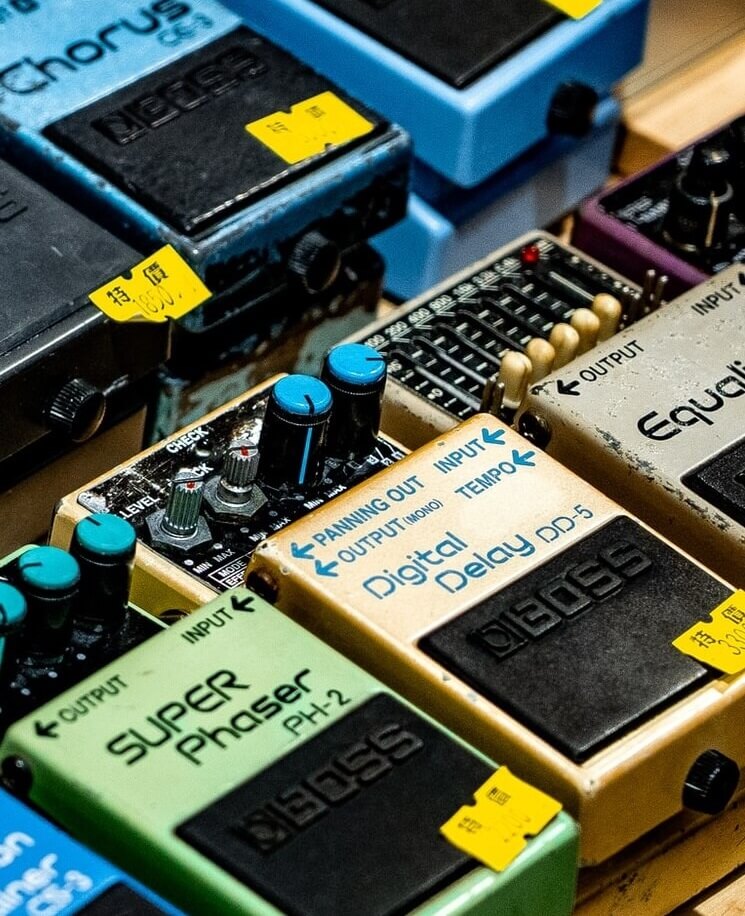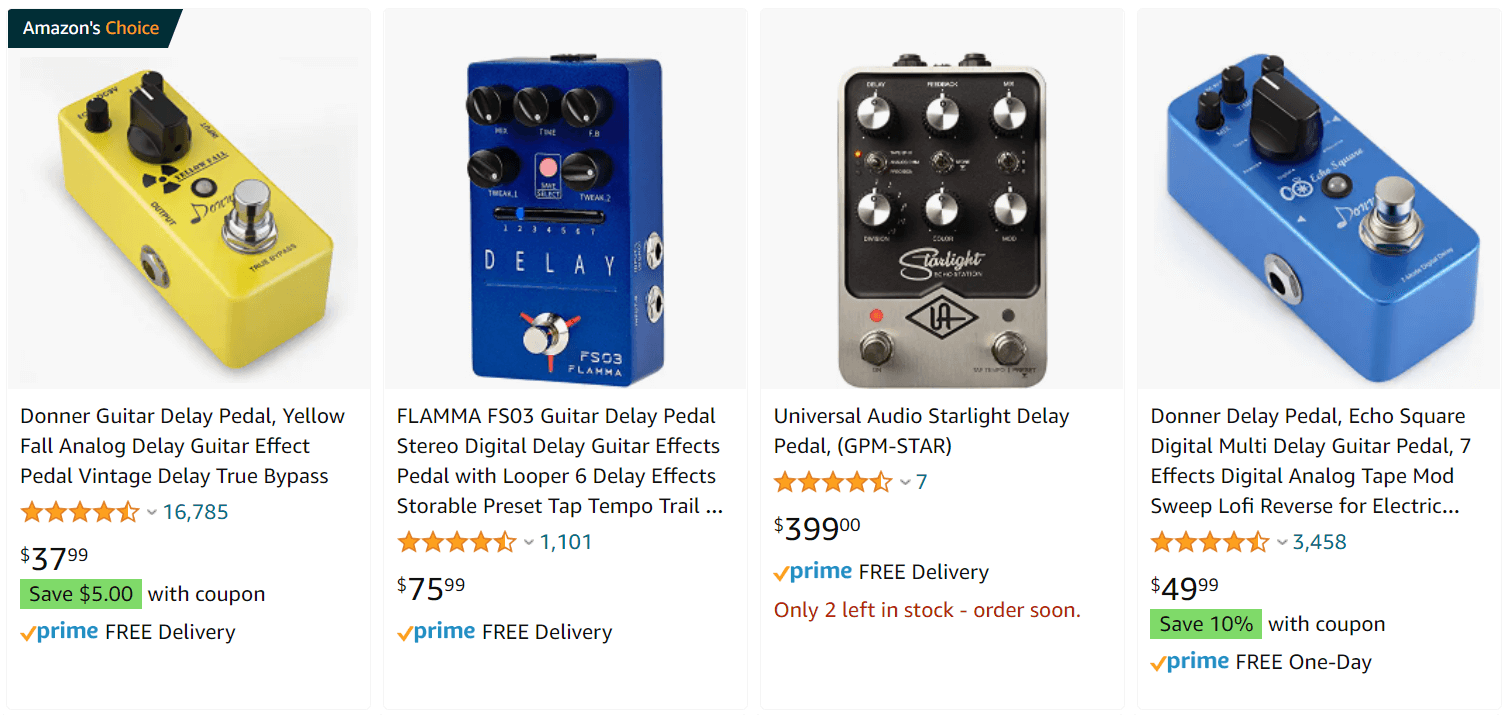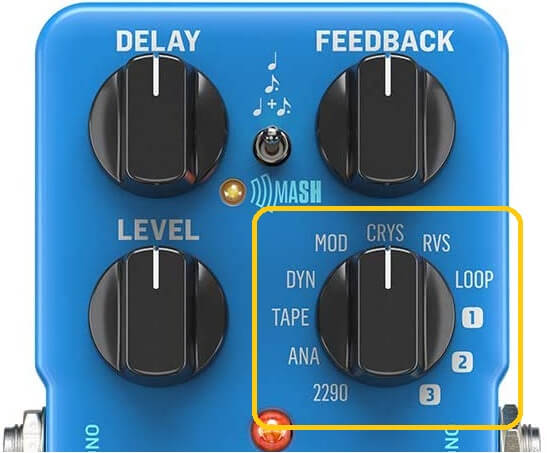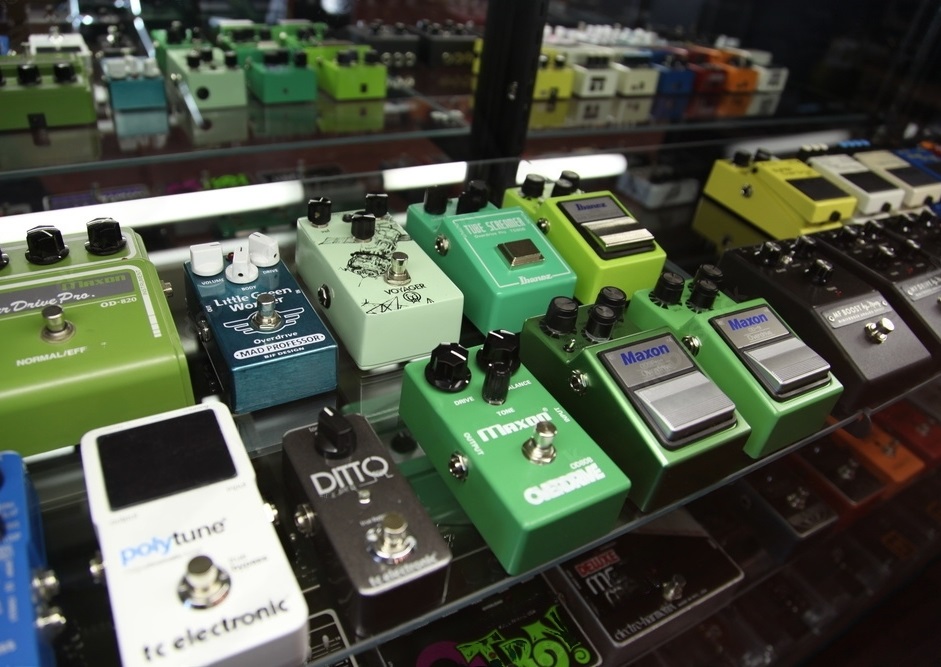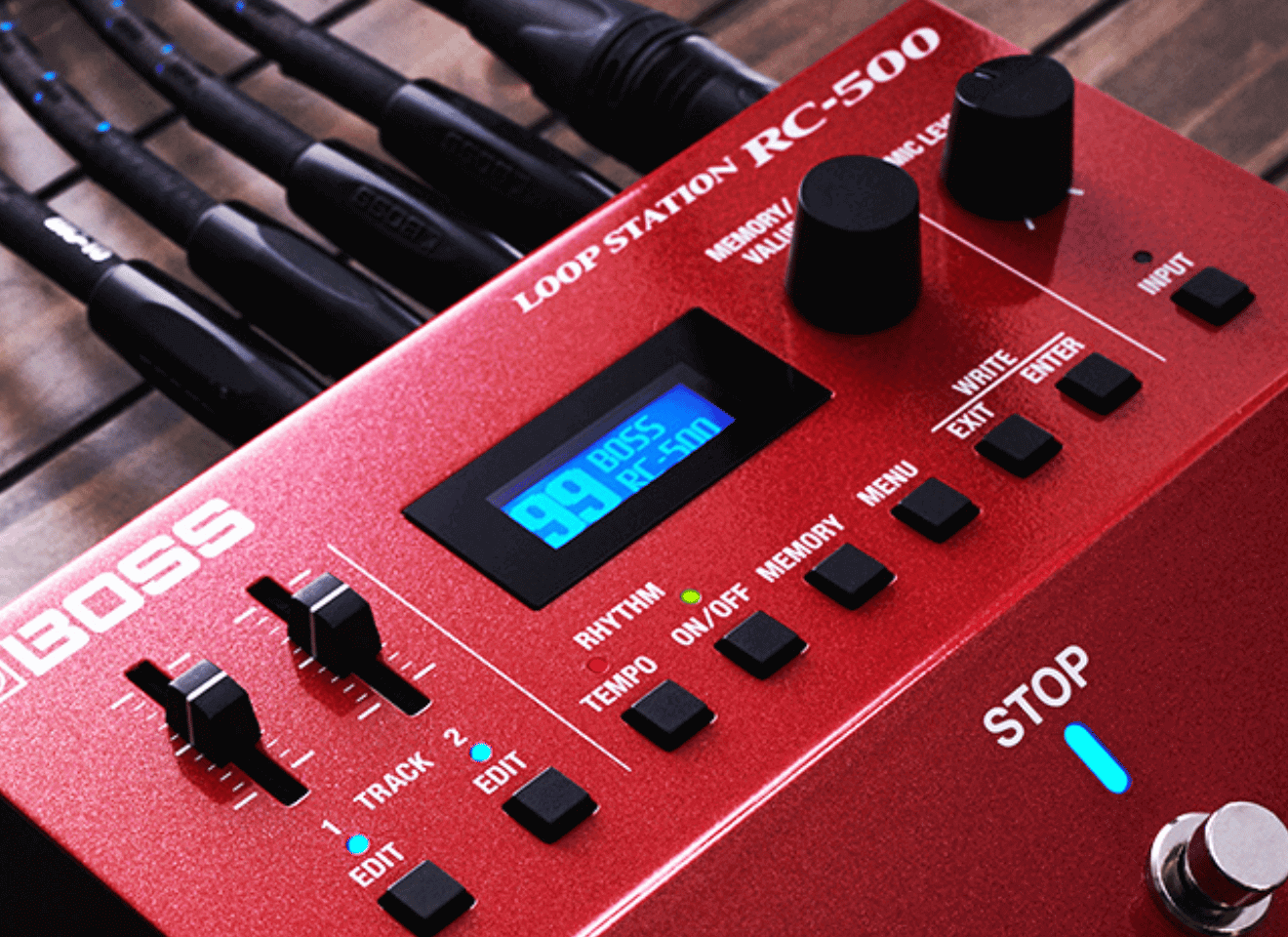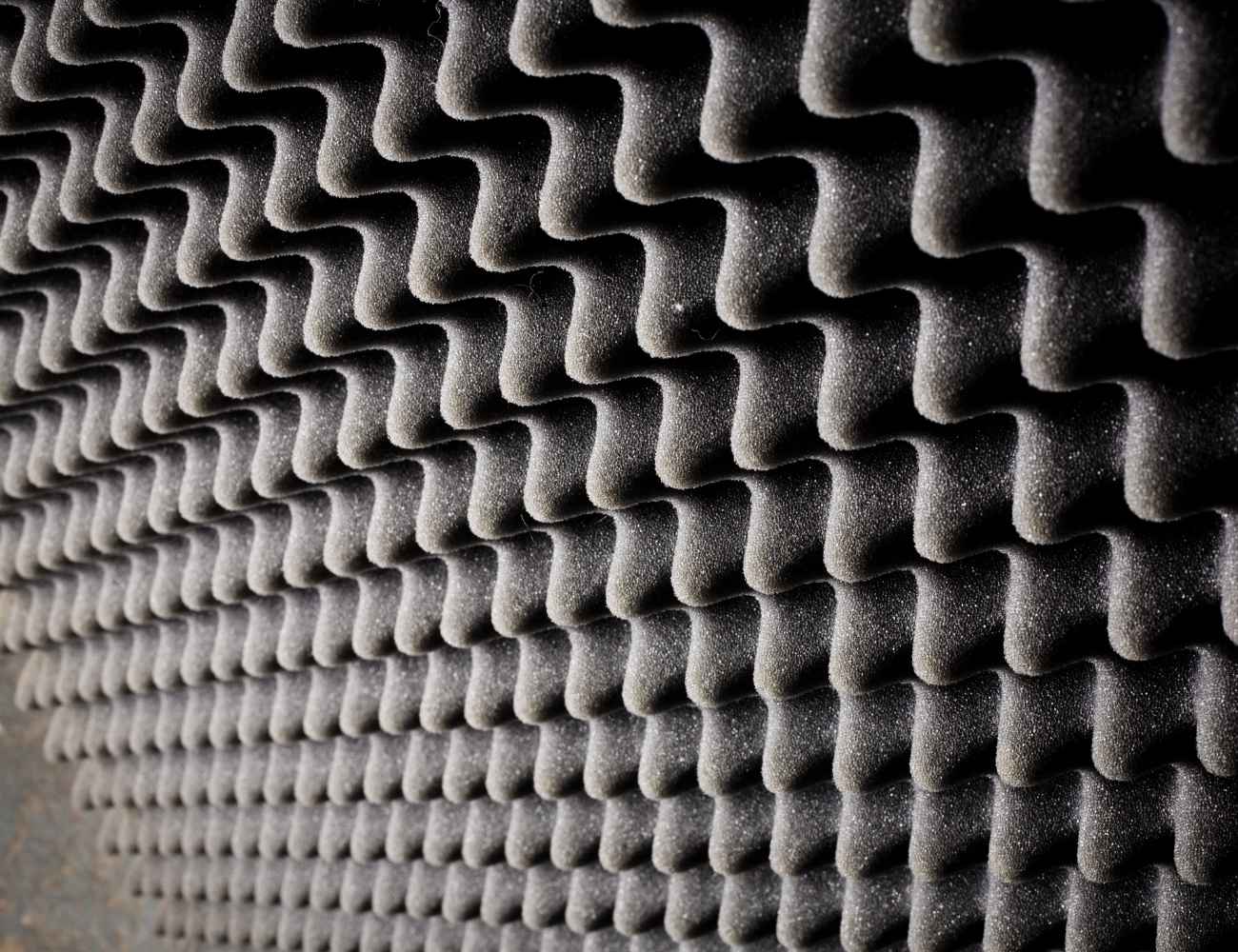Let’s face it, we all want to have a great guitar tone and unleash our inner guitar gods.
Sometimes a delay pedal can make all the difference and take you a few steps closer to that ideal tone.
But with so many options available, which one do you chosse?
There is a world of difference between a cheap, store-bought delay pedal and a high-end model.
When it comes to choosing your perfect delay pedal, it’s important to understand the different types of delays available and what each one can do for your sound.
In this post, I will be listing the best delay pedals on the market today in terms of quality, durability, versatility, and price, and will also answer some of the most frequently asked questions on this topic.
We’ll discuss the features of each pedal and how they can improve your music-making and playing experience.
Table of Contents
- Best Delay Pedals
- BOSS DD-8 Guitar Effect Delay Pedal
- MXR M169 Carbon Copy Analog Delay Pedal
- JHS Pedals 3 Series Delay Pedal
- TC Electronic Flashback 2 Delay Effects Pedal
- Donner Yellow Delay Guitar Pedal
- Dunlop Echoplex Delay Guitar Pedal
- Lotmusic Analog Delay Effect Pedal
- Donner Echo Square Delay Pedal
- FLAMMA Digital Stereo Delay Pedal
- Seymour Duncan Vapor Trail Delay Pedal
- Boss DD-500 Digital Delay Pedal
- Strymon TimeLine Delay Effects Pedal
- TC Electronic ECHOBRAIN Vintage-Style Delay Pedal
- Electro-Harmonix Canyon Delay & Looper Pedal
- Boss DM-2W Waza Craft Delay Pedal
- Walrus Audio ARP 87 Multi Function Delay Pedal
- Boss DD-3T Digital Delay Pedal
- What exactly is a delay pedal?
- What to consider before buying a guitar delay pedal?
- Analog vs Digital delays: Which one should you use?
- Which is better: Reverb or Delay?
- Should you use reverb and delay together?
- Are delay pedals necessary to have on a pedalboard?
- How to order pedals on a pedalboard?
- Boutique vs. Mass-Produced pedals
- How much should you spend on a guitar pedal?
- Can you use a guitar pedal with a bass guitar?
- How to properly power your pedals?
Best Delay Pedals
Before I begin, here are my top selected choices:
TC Electronic Flashback 2 Delay Effects Pedal

Legendary delay pedal with revolutionary MASH expression footswitch. Check Price
|
|
Lotmusic Analog Delay Effect Pedal

Lotmusic Analog Delay for smooth, warm delay tones with adjustable delay time and True Bypass. Check Price
|
BOSS DD-8 Guitar Effect Delay Pedal
Legendary BOSS quality and performance with versatile delay, reverb, looper, and advanced features.
BOSS provides quality guitar effects, amplifiers, and other related products, trusted by professional musicians for superior sound and reliable performance. They offer a wide range of tones and textures for any genre, staying ahead of the curve with innovative products.
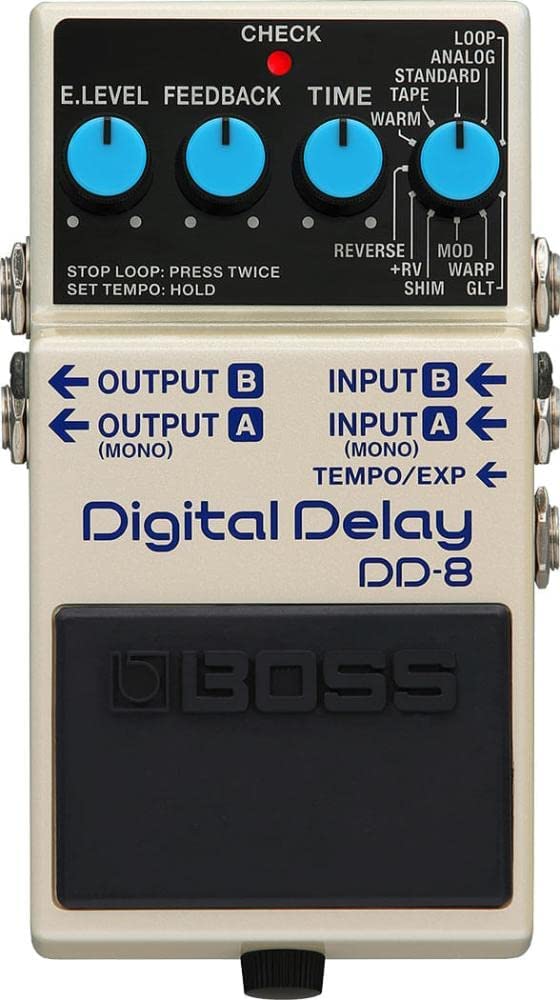
The Boss DD-8 Digital Delay Pedal is a feature-rich and versatile delay pedal for guitarists, offering an impressive range of sounds and options in a compact, easy-to-use design.
This pedal provides 10 seconds of delay, true stereo I/O with three output modes, a 40-second looper with overdub functionality, and two footswitch inputs.
Additionally, it has a carryover switch for a smooth transition between effects.
This multi-color pedal is made by Boss, a reputable brand known for superior quality and innovation in the world of guitar effects.
The DD-8 measures 5.95 x 3.8 x 2.6 inches and weighs 0.49 kilograms, making it a convenient addition to any guitar rig.
Equipped with eleven distinct modes, the DD-8 offers an array of delay styles ranging from classic to more experimental.
In addition, its looper feature allows unlimited overdubbing and can be controlled externally for added flexibility.
Given its wide array of features and compact size, the Boss DD-8 is an excellent solution for guitarists seeking a powerful yet practical delay pedal.
- My Review
Upon getting my hands on the Boss DD-8 Digital Delay Pedal, I was thrilled by its sleek, compact design and many remarkable features.
Right out of the box, I was impressed with the pedal’s build quality, a testament to Boss’s commitment to creating durable, reliable products that stand the test of time.
As I tinkered with the DD-8’s vast array of delay modes, exploring its sonic possibilities, I deviated from my usual playing style.
I was like a kid in a candy store, sampling different treats, each offering its unique flavor.
The classic delay sounds were spot-on, and the more exotic settings opened up new creative avenues to explore and craft my sound.
The looper feature turned out to be the cherry on top, allowing me to add depth and substance to my solos and even create intricate layerings I hadn’t considered before.
In addition, the unlimited overdubbing capability and external control support ushered in a whole new world of possibilities without taking up extra valuable pedalboard real estate.
If I must find one, my only quibble is that the DD-8 might not be as heavily customizable as some of its higher-end counterparts, like the Strymon or Walrus delays.
However, considering its price tag, durability, and many features, the Boss DD-8 still goes above and beyond to offer massive value to musicians looking for a robust delay pedal.
Here are the ratings I’ll give to the BOSS DD-8 Guitar Effect Delay Pedal:
Like a Swiss Army Knife, the Boss DD-8 Digital Delay Pedal has proven to be a multi-functional, practical, and versatile tool that any guitarist can brandish to elevate their sound.
This pedal has met and exceeded my expectations, and I know it will continue to be a faithful companion on my musical journey.
- Pros:
- Compact and durable design
- Variety of delay modes
- Looper with unlimited overdub
- Cons:
- Less customizable than higher-end delays
- No included power adapter
- Instructions not very detailed
My final verdict is that the Boss DD-8 Digital Delay Pedal is an excellent investment for any guitarist seeking a high-quality, feature-rich, and versatile delay pedal that offers great value for money.
MXR M169 Carbon Copy Analog Delay Pedal
Rich, all-analog delay with bucket-brigade technology.
MXR is a manufacturer of high-quality guitar effects pedals, featuring true bypass circuitry and a wide range of sounds. Their range of distortion, chorus, delay, EQ, wah, and more offer great sound quality and versatility for any guitarist.
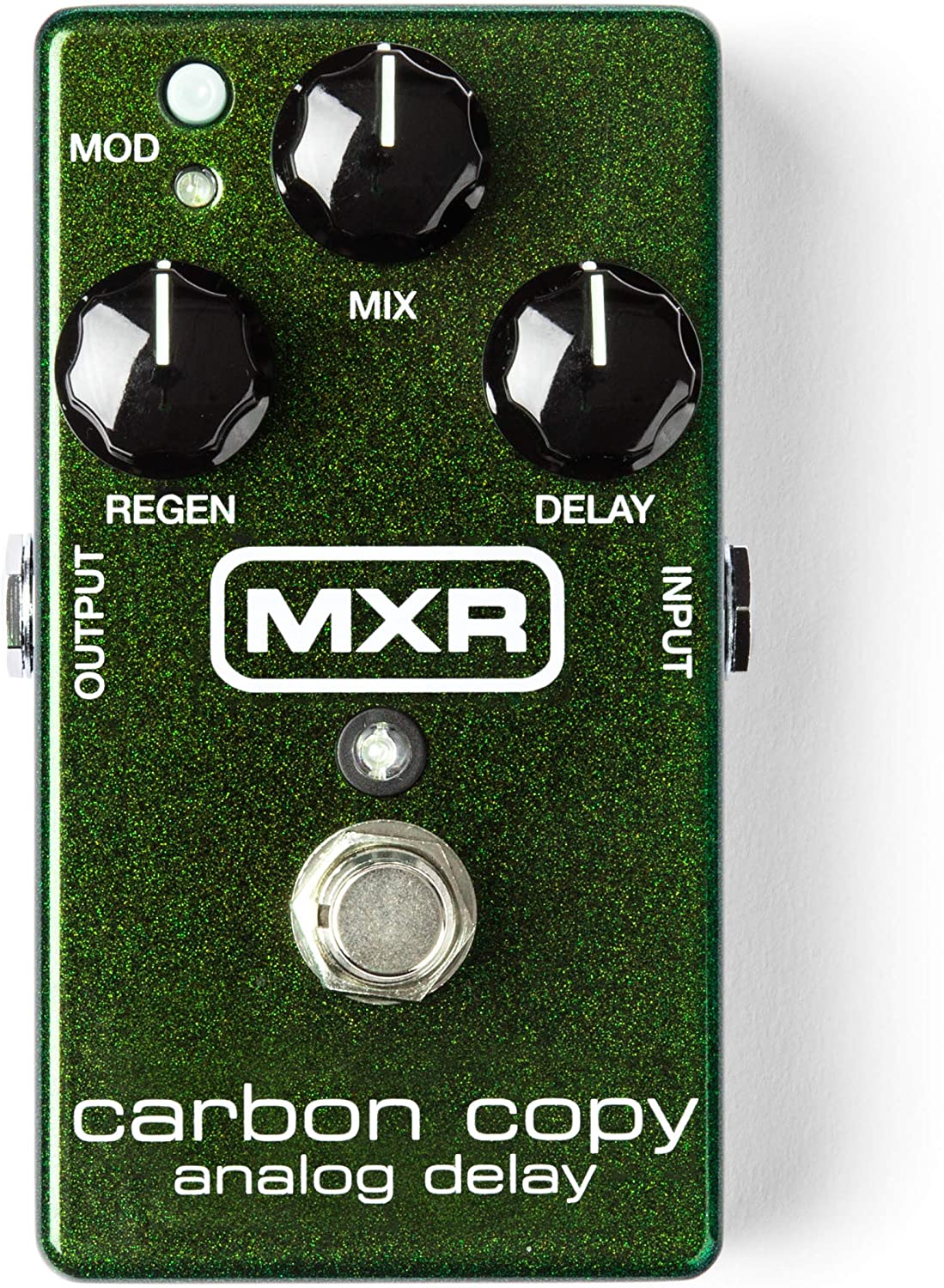
The Jim Dunlop Carbon Copy Analog Delay Guitar Effects Pedal is a high-quality, all-analog delay pedal designed to provide a rich and warm sound to your guitar playing.
With up to 600 milliseconds of delay time, this pedal allows for a wide range of echo effects, from subtle touches to more pronounced and complex patterns.
One standout feature is the pedal’s modulation controls, which help emulate vintage tape echo tones for a truly authentic sound.
In addition, the pedal utilizes bucket-brigade technology, a classic approach to analog delay, ensuring a smooth and organic tone.
The Jim Dunlop Carbon Copy Analog Delay Pedal is housed in a durable green casing with 5.5 x 2.5 x 4.5 inches dimensions, making it a compact addition to your pedalboard.
In addition, the item weighs just 1 pound, ensuring it’s easy to transport and set up.
The model number for this pedal is M169, and it comes from the reputable JIM DUNLOP brand, well-known as a leader in guitar effects pedals.
- My Review
I have to admit, when I first got my hands on the Jim Dunlop Carbon Copy Analog Delay Guitar Effects Pedal, I was pretty excited to try it out.
As an avid player, I’ve been searching for the perfect delay pedal to add that extra touch to my music, and this one seemed promising.
With its rich, all-analog delay, the Carbon Copy offers up to 600 milliseconds of delay time, allowing for a wide range of creative possibilities.
While experimenting with this pedal, I couldn’t help but be impressed with the modulation controls that managed to emulate those classic tape echo tones we all know and love.
In addition, the bucket-brigade technology within the model sets it apart from other pedals in the market.
I found this green-hued wonder’s compact design quite appealing, and its easy-to-use controls made adjusting my sound a breeze.
It didn’t take long to realize that this pedal truly shines when playing on a clean channel.
The natural and organic warmth it adds to the tone is simply unmatched.
However, I did notice that when I kicked in the distortion, it didn’t quite deliver the same lush experience, which was a slight disappointment.
Although I missed the presence of a tap tempo controller, I appreciated the simplicity of the Carbon Copy.
It might not have all the bells and whistles of some other pedals, but it truly excels in its craft when delivering warm, spacious, and natural-sounding delays.
Here are the ratings I’ll give to the MXR M169 Carbon Copy Analog Delay Pedal:
So, despite a few minor downsides, the Jim Dunlop Carbon Copy Analog Delay Pedal is a solid choice for musicians seeking that distinctly vintage delay sound.
It has carved a permanent spot in my pedalboard, and I can confidently say it’s a worthy investment for any guitarist looking to up their game.
- Pros:
- Rich, all-analog delay
- Up to 600 milliseconds delay time
- Modulation controls for tape echo tones
- Cons:
- No tap tempo or subdivisions control
- Some reported feedback and line noise
- Potential durability issues in some cases
My final verdict is that the Jim Dunlop Carbon Copy Analog Delay Guitar Effects Pedal is a reliable and high-quality option for those seeking a warm, all-analog delay.
Its modulation controls and rich tone add depth and character to your sound.
However, it may have some limitations concerning tap tempo control and occasional feedback issues.
Overall, this pedal offers a great balance of quality, performance, and value, making it a solid choice for many guitarists.
JHS Pedals 3 Series Delay Pedal
JHS Pedals 3 Series offers versatile, simple-to-use effects.
JHS Pedals 3 Series Delay offers classic delay sounds, ranging from warm and dark to bright and pristine, with a simple, easy-to-use design and up to 800ms of delay time. It features a Type toggle for digital or analog sounds and a Repeats knob for classic bucket brigade runaway in analog mode.
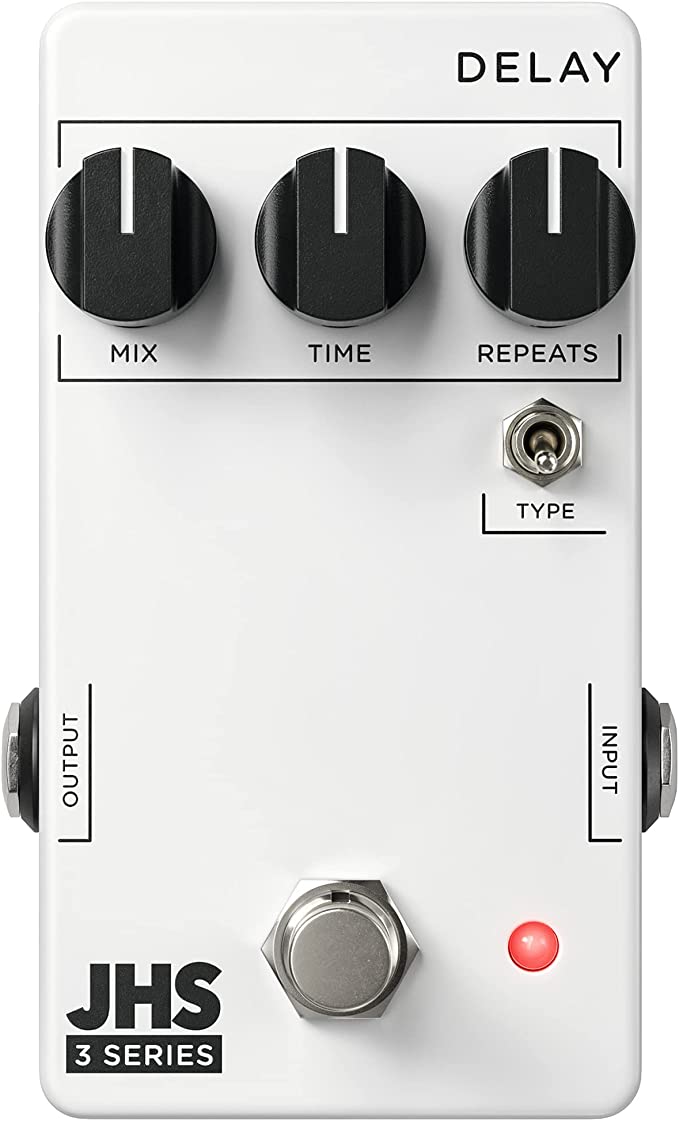
The JHS Pedals 3 Series Delay is a versatile, high-quality delay pedal designed and manufactured in Kansas City, USA.
This effect pedal offers a delay time range of 80ms to 800ms, allowing users to create anything from short slapback echoes to lengthy, pad-like ambient soundscapes.
Featuring a Type toggle switch, musicians can easily choose between a crisp digital delay or a vintage-inspired analog delay.
One remarkable aspect of this pedal is its capability to mimic classic bucket brigade effects when the Repeats knob is maxed out in analog mode.
A 9V DC negative center powers the 3 Series Delay and consumes a mere 71mA.
Its dimensions are 4 x 3 x 2 inches, weighing 0.65 pounds.
In addition to its fantastic sound quality and practicality, this pedal is part of the larger JHS Pedals 3 Series family, which includes various effects such as chorus, compressor, distortion, and reverb.
- My Review
After testing the JHS Pedals 3 Series Delay, I found it an exceptional and versatile delay pedal.
Its ability to offer a wide range of delay times from 80ms to 800ms makes it adaptable for various musical styles, especially when experimenting with different slapback echoes or creating immersive ambient soundscapes.
One aspect that impressed me was the Type toggle switch, allowing me to effortlessly choose between a crystal-clear digital delay and a warm, vintage-inspired analog delay sound.
When maxed out in analog mode, the Repeats knob adds a distinct charm reminiscent of the classic bucket brigade effects—an unexpected, nostalgic touch I quickly grew fond of using.
Initially, I was slightly concerned about the pedal’s power consumption and weight, but after some use, the 9V DC negative center power turned out to be quite efficient, with only 71mA consumption.
Also, the pedal’s 0.65-pound weight was manageable within my pedalboard setup.
Being part of the broader JHS Pedals 3 Series family, this delay effect beautifully complements other JHS effects like chorus, compressor, distortion, and reverb.
However, I did notice a slight volume boost when activating the pedal, which required some fine-tuning to achieve unity gain—an issue that may initially frustrate some users.
In terms of appearance, the minimalistic design and vintage sci-fi look contribute to an overall pleasant aesthetic.
I appreciated the clean and modern lines and found that they reflected the pedal’s ethos of simplicity and versatility.
Here are the ratings I’ll give to the JHS Pedals 3 Series Delay Pedal:
Ultimately, the JHS Pedals 3 Series Delay has become a steadfast component of my sound setup, offering an impressive range of delay options and stellar performance.
Despite the minor volume boost issue, this pedal brings tremendous value and versatility to anyone looking to elevate their sound.
- Pros:
- Versatile delay time range.
- Toggle switch for analog/digital mode.
- Efficient power consumption.
- Cons:
- Minor volume boost issue.
- Requires fine-tuning for unity gain.
- No other significant drawbacks.
My final verdict is that the JHS Pedals 3 Series Delay is an impressive, versatile, and valuable addition to any musician’s pedalboard.
With its excellent tone options, user-friendly features, strong performance, and great value, it is highly recommended for those looking to enhance their sound.
TC Electronic Flashback 2 Delay Effects Pedal
Legendary delay pedal with revolutionary MASH expression footswitch.
FLASHBACK 2 DELAY is a feature-packed delay pedal with groundbreaking MASH footswitch, TonePrint technology and 8 stunning delay options, including Crystal delay algorithm and two additional TonePrint slots. Its MASH technology adds an expression pedal for creative expression and saves pedalboard space.
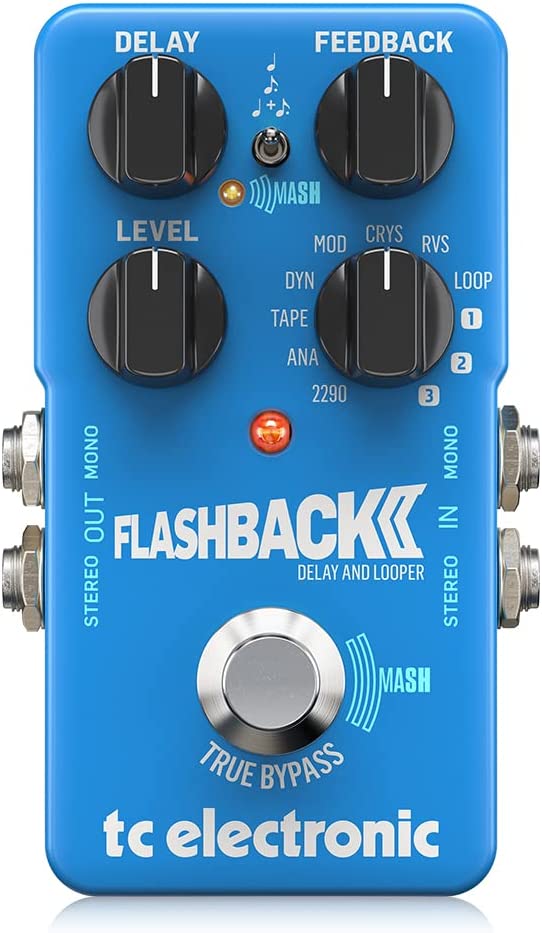
The TC Electronic Flashback 2 Delay Pedal is a compact and versatile delay pedal that packs an impressive range of features into a small package.
Designed for guitarists who value quality and innovation, this pedal combines the company’s legacy of delay effects with groundbreaking MASH technology.
MASH, short for “touch-sensitive expressiveness,” replaces the need for an expression pedal and allows users to control various aspects of the effect by simply applying pressure to the footswitch.
This unique approach saves precious pedalboard space and provides a more hands-on playing experience.
Offering eight different delay options, including a new, shimmering Crystal effect, the Flashback 2 Delay caters to guitarists of various styles and genres.
Additionally, the pedal is TonePrint-ready, allowing users to access the TonePrint library, where they can download custom presets from legendary artists or even create their own using the free TonePrint Editor for PC, Mac, and iPad.
Other important features include an Analog-Dry-Through design, ensuring your natural guitar signal remains unaffected, and choosing between True Bypass or Buffered Bypass switches for optimum tonal integrity.
- My Review
I recently had the chance to try out the TC Electronic Flashback 2 Delay Pedal, and let me tell you, it’s quite the showstopper!
This compact yet versatile delay pedal delivered impressive features, allowing me to explore a universe of tones and effects.
I was particularly taken by the MASH technology – what a game-changer!
Feeling the pedal respond to the pressure of my foot was like conversing with the music itself, and it was an incredibly intuitive experience.
One of this pedal’s standout aspects is its abundance of delay options.
With eight different settings, including the stunning new Crystal delay, this pedal opened up a world of creative possibilities.
But, I must admit, the Crystal delay’s ethereal shimmer had me in a trance – I could genuinely feel my mind soaring through celestial realms of sonic perfection!
As I dug deeper into the Flashback 2, I discovered the magic of being TonePrint-ready.
I could easily access fascinating presets from rock legends.
Still, the option to craft my custom delay using the TonePrint Editor gave me a sense of control and personalization that I truly appreciated.
I will point out, though, that the MASH technology, while innovative, can take some getting used to.
It’s not the most straightforward function, but that’s the beauty of exploration – it invites growth and the development of new techniques.
Here are the ratings I’ll give to the TC Electronic Flashback 2 Delay Effects Pedal:
If I were to pinpoint a downside, it would be the absence of a tap tempo, which was available in the first version but not in this one.
For some, that might be a deal-breaker, but it didn’t stop me from enjoying the many other features the Flashback 2 offers.
- Pros:
- Innovative MASH technology.
- Eight versatile delay options.
- TonePrint customization.
- Cons:
- Tap tempo missing.
- MASH requires a learning curve.
- TonePrint Editor can be buggy.
My final verdict is that the TC Electronic Flashback 2 Delay Effects Pedal is a fantastic, feature-rich pedal that offers guitarists various delay options and innovative MASH technology.
Its TonePrint customization and acclaimed delay algorithms make it a valuable addition to any pedalboard.
However, the lack of tap tempo might be a drawback for some players, and the MASH function has a learning curve.
It’s a great investment for musicians seeking versatility and creativity in their delay effects.
Donner Yellow Delay Guitar Pedal
Donner’s Yellow Fall Analog Delay Pedal provides classic delay sound and easy, flexible controls.
Yellow Fall is an easy-to-use analog delay pedal that provides classic delay sounds. Its pure analog design delivers smooth and warm tones, while the high-quality components and circuit design keep your tone clear and pure. With its aluminum alloy casing and True Bypass circuitry, the Yellow Fall pedal offers reliable performance and a transparent tone.
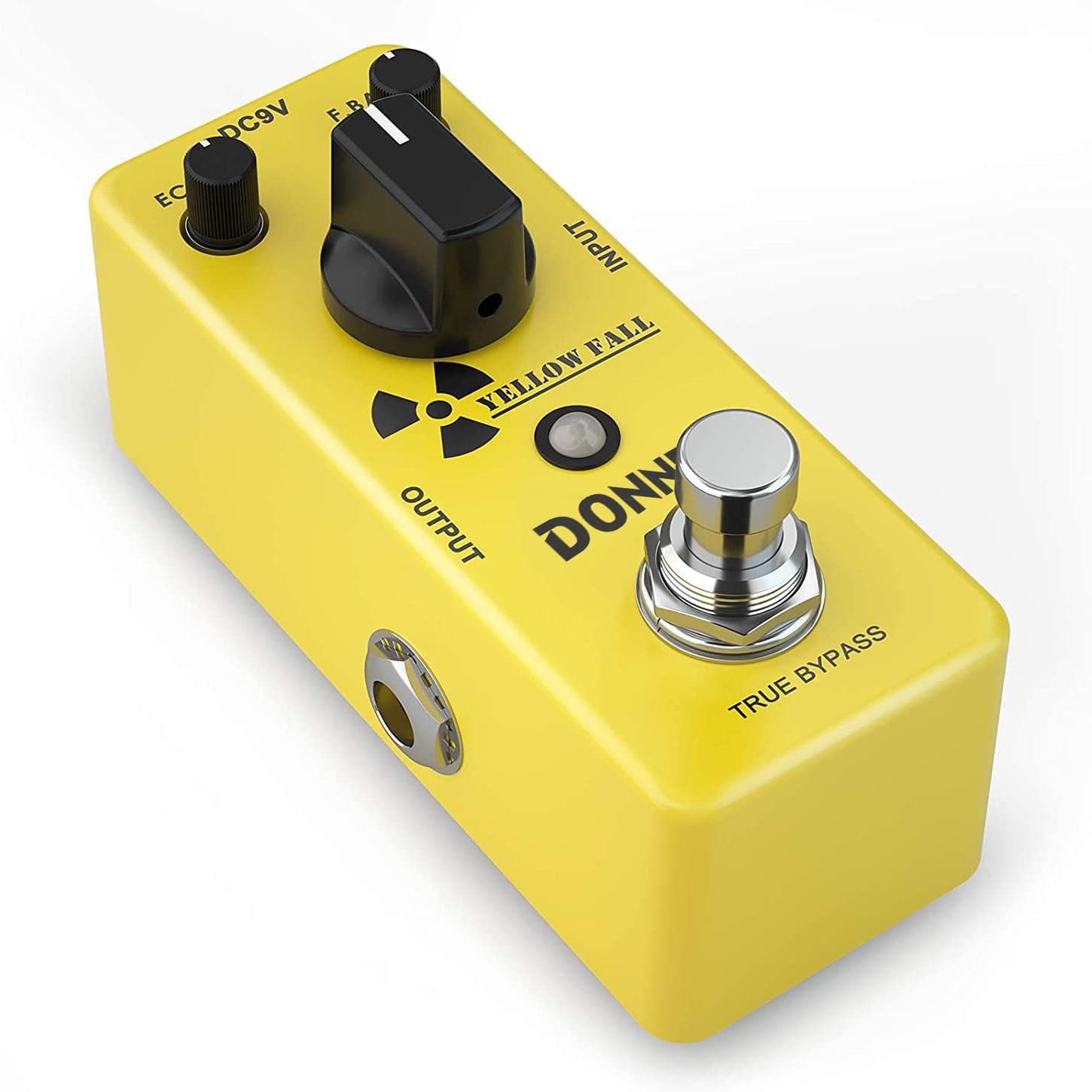
The Donner Guitar Delay Pedal is a top-quality analog delay effect pedal expertly crafted to provide vintage warmth and natural tones, giving you complete control over your sound.
The Yellow Fall model features a range of delay times between 20ms and 620ms, allowing you to achieve the perfect delay level and feedback to suit your playing style.
In addition, this durable pedal boasts a strong aluminum-alloy construction and true bypass functionality, ensuring transparent tone and top-notch performance.
The Donner Delay Pedal is designed for guitars and provides a versatile palette of sonic options.
The LED indicator keeps you informed of the working state, and the pedal operates on a 9-volt power supply (not included).
With dimensions of 4.7 x 3 x 2.5 inches, this pedal in yellow color is compact yet powerful.
The Donner brand is known for crafting high-quality, affordable musical instruments and accessories to inspire your sound, and this delay pedal is no exception.
Create your unique tone with the Donner Guitar Delay Pedal and experience a world of possibilities for your music setup.
- My Review
As someone who has personally tried the Donner Guitar Delay Pedal, Yellow Fall Analog Delay Guitar Effect Pedal Vintage Delay True Bypass, I have to say that it’s a solid choice for guitarists who are keen on adding a touch of classic vintage analog delay to their sound.
It’s got a robust construction – holding its weight when you take it out of the box.
It also has excellent build quality with a strong aluminum alloy casing that screams reliability.
What I love about this pedal is its simplicity and straightforward use.
The Yellow Fall’s analog design brings out smooth, warm delay tones reminiscent of old-school rock and jazz vibes.
The pedal comes with three knobs – Echo, Time, and Feedback – that provide a wide range of customization.
The Time knob, in particular, offers varying delay times from 20ms to 620ms, allowing you to change your echo effect on the fly.
However, it’s important to note that this pedal does not have a power supply in the package, so you’ll need to purchase a separate 9V DC adapter to get it up and running.
That being said, the pedal itself isn’t perfect – the range on the speed knob can be a bit touchy, and in some cases, it might not be as accurate as a digital delay.
But let’s be honest, we’re talking about an analog delay pedal that brings a specific charm to the table.
Having used this pedal for both live gigs and at-home jam sessions, you can’t deny the value it brings for its affordable price.
Here are the ratings I’ll give to the Donner Yellow Delay Guitar Pedal:
Now and then, you might run into some minor issues, like feedback loops, if you’re not careful with the Feedback knob, but the overall sound the Yellow Fall produces genuinely makes it worth a try.
It might not be the best delay pedal out there, but it delivers for those on a budget who still want to create mesmerizing echoes in their music.
- Pros:
- Affordable and budget-friendly.
- Sturdy and well-built design.
- Flexible and versatile functions.
- Cons:
- Signal noise issues in some units.
- Power supply not included.
- Tone accuracy concerns reported.
My final verdict is that the Donner Guitar Delay Pedal is a budget-friendly, good-value option for beginners and hobbyists who want a simple yet functional delay pedal.
While it may not have all the high-end features of more expensive pedals, it has a relatively easy interface, satisfactory performance, and a compact design for its price range.
However, more experienced or professional musicians might invest in a higher-end pedal with added precision and versatility in the long run.
Dunlop Echoplex Delay Guitar Pedal
Vintage tones and modern features in a compact pedal.
The EP103 Echoplex Delay recreates the classic EP-3 echo tones in a miniature footprint, featuring Age Mode for added tape saturation and modulation, Tap Tempo, relay/trails bypass, and stereo input/output. Create vintage-inspired guitar tones with this unique and versatile delay pedal.
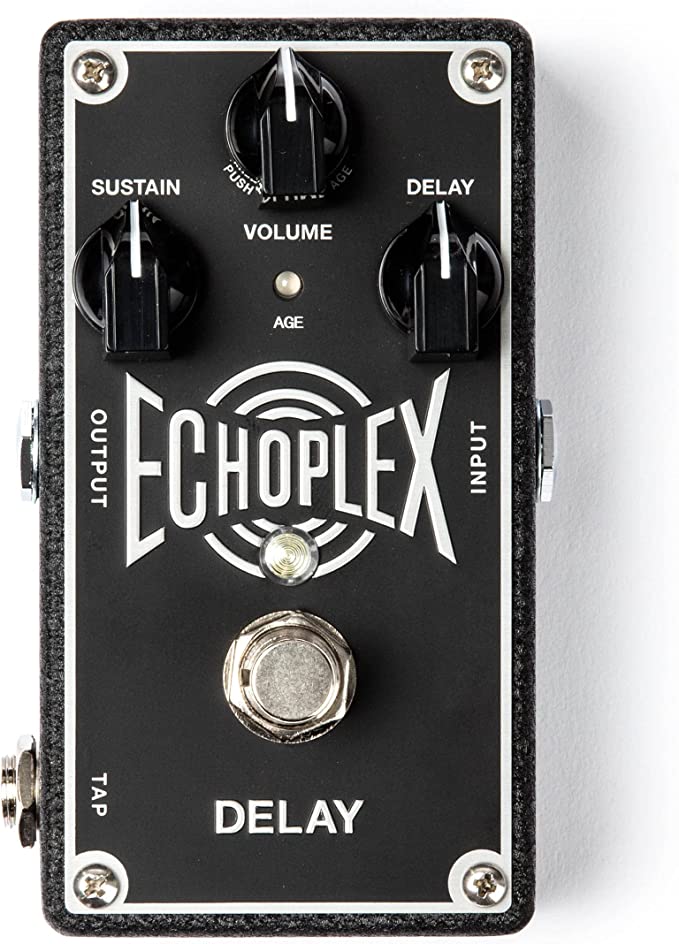
The Dunlop Echoplex Delay is a remarkable guitar effects pedal that aims to emulate the iconic and warm tones of the vintage Echoplex EP-3 tape echo unit.
This compact pedal achieves the legendary sound while being much smaller and more reliable than its inspiration.
With its simple control interface and all-analog dry path, you can easily dial in that classic sound, ranging between 40-750ms of delay time.
One of the standout features of the Echoplex Delay is its Age control, allowing you to vary the tone from pristine to dark and textured, simulating the wear and tear of an original tape unit.
Additionally, the pedal offers tap tempo functionality with an external switch, making it even easier to match the delay time to your music.
Packed in sleek black housing, the Echoplex Delay is built by the renowned brand, Jim Dunlop, ensuring high-quality workmanship and performance.
With its flexible settings and authentic tape echo sound, this pedal is perfect for musicians looking to add a touch of vintage warmth and character to their tone.
- My Review
My experience with the Dunlop Echoplex Delay has been transformative.
This guitar effects pedal takes me on a sonic journey, capturing the essence of the vintage Echoplex EP-3 tape echo unit while adding modern conveniences and reliability.
One of the first things I noticed about this pedal was its intuitive interface.
Adjusting the settings for delay time, sustain, and volume felt like a breeze, allowing me to focus more on exploring the rich, warm tones it produces.
In addition, the Age control brought my sound to life, allowing me to inject a touch of darkness and grit when desired, simulating the charm of an old, well-worn tape unit.
I particularly appreciate the tap tempo functionality, which made syncing the delay to my music a seamless process.
Adding an external switch for even greater control takes this feature to the next level.
Perhaps the most mesmerizing aspect of the Echoplex Delay is its capacity for sonic sculpting.
I found myself effortlessly weaving intricate tapestries of sound, from gentle, subtle ambiance to bold, otherworldly effects.
The versatility of this pedal truly sets it apart as a creative tool, making it a must-have addition to any rig.
Of course, no product is without its flaws.
I found the lack of battery power option limiting, and the occasional switch noise could be distracting during live performances.
However, these minor hiccups did not detract from the overall greatness of this pedal.
In my personal experience, the Dunlop Echoplex Delay offers an unparalleled blend of vintage nostalgia and contemporary utility.
Here are the ratings I’ll give to the Dunlop Echoplex Delay Guitar Pedal:
Its exceptional sound quality, ease of use, and creative potential make it a standout effects pedal.
I wholeheartedly recommend it to fellow musicians seeking to add a touch of magic to their arsenal.
- Pros:
- Authentic vintage tape echo sound.
- Intuitive interface and controls.
- Exceptional sonic sculpting capabilities.
- Cons:
- No battery power option.
- Occasional switch noise.
- Pricier than some competitors.
My final verdict is that the Dunlop Echoplex Delay is a fantastic effects pedal that offers a unique blend of vintage charm and modern functionality.
Its rich, warm tones, intuitive controls, and impressive versatility make it a standout choice for any musician looking to enhance their sonic palate.
While it may be priced higher than some competitors, this pedal’s exceptional sound quality and creative potential make it a true gem worth considering for your rig.
Lotmusic Analog Delay Effect Pedal
Lotmusic Analog Delay for smooth, warm delay tones with adjustable delay time and True Bypass.
This Lotmusic digital delay pedal offers true bypass, adjustable delay time and mix knob, and a full metal shell for touring reliability. It’s perfect for a wide range of music styles, providing smooth, warm delay tones and minimal noise swells. Perfect for guitarists wanting to get the best sound from their instrument.
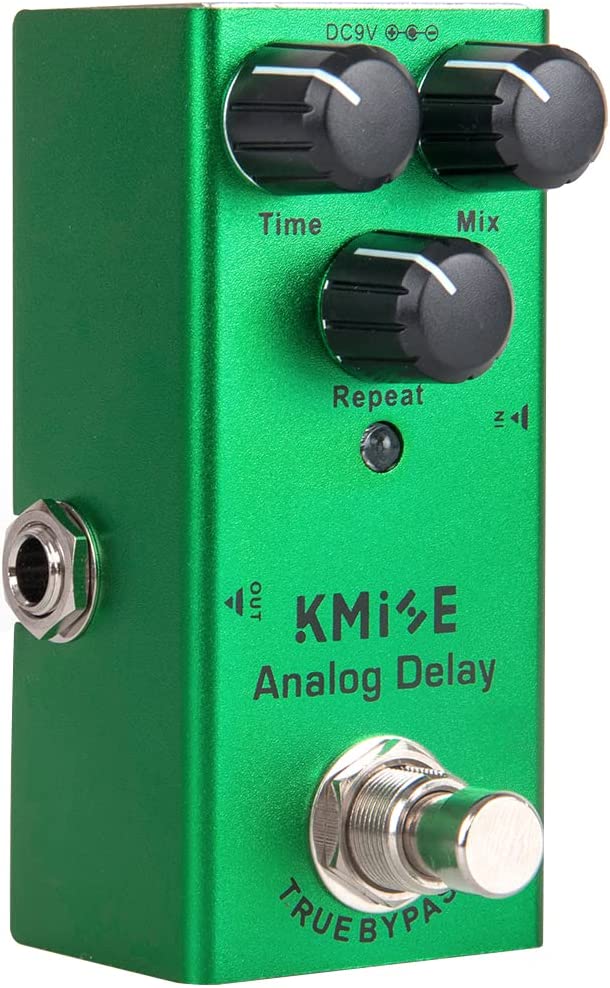
This Lotmusic analog delay pedal is a compact, high-quality electric guitar effects gadget designed to deliver outstanding noise reduction in an easy-to-use package.
Crafted using advanced technology, this delay pedal reduces the common noise swells associated with analog delay circuits, producing a quiet and pure effect.
With true bypass switching, you can maintain signal flow without interruption when the pedal is disengaged.
The pedal features dedicated Time, Mix, and Repeat knobs, allowing precise effect tailoring to suit your personal preferences.
Built for durability, the device is encased in robust aluminum alloy housing, ensuring reliable performance during transportation and on-stage performances.
This mini-sized effects pedal is lightweight and suitable for outdoor gigs, powered with a DC 9V adapter (not included).
Lotmusic promises a lifetime of support for this inexpensive, easy-to-use analog delay pedal.
For any issues, contact the manufacturer, and they will assist you in finding the perfect solution.
- My Review
After unboxing and carefully setting up my new Lotmusic Analog Delay pedal, I couldn’t wait to plug in my guitar and dive right into testing it.
The first thing that stood out was the pedal’s solid build quality.
The aluminum alloy body presented itself as attractive and reliable, convincing me it could withstand the rigors of live performances and constant transportation.
As I worked through the pedal’s settings, I was delighted to discover just how seamless its noise reduction capabilities were.
Removing the unwanted hum that often plagues analog delay circuits was truly impressive, and the true bypass design ensured that my signal remained crystal clear and uninterrupted.
Exploring further, I found the dedicated Time, Mix, and Repeat controls incredibly useful in fine-tuning my desired effect.
In addition, the wide range of possible delay times — from a short 20ms up to a full 600ms — offered ample versatility to suit various music styles.
However, this pedal wasn’t without a few minor flaws.
While the high-quality chip technology provided overall great sound, I noticed some inconsistencies in the decay, which sometimes seemed slightly harsh and digital.
Furthermore, the self-oscillation was a tad thin and less pleasing than I had hoped for once I pushed the repeat knob past the halfway mark.
That being said, for a device at such an affordable price point, the value of the Lotmusic Analog Delay cannot be overstated.
Here are the ratings I’ll give to the Lotmusic Analog Delay Effect Pedal:
Although it might not be a top-tier option for professional musicians seeking perfect performance in every aspect, this pedal is a fantastic addition to any hobbyist’s arsenal.
Beginners looking to experiment with different effects, or even seasoned players seeking backup pedals for gigs, will find an unrivaled balance of quality and affordability in this versatile gadget.
- Pros:
- Noise reduction technology.
- True bypass for pure signal.
- Compact and easy to carry.
- Cons:
- DC 9V adapter not included.
- Some say harsh repeats.
- Possible quality control issues.
My final verdict is that the Lot Music Analog Delay Electric Guitar Effects Pedal is a decent choice for those looking for an affordable, compact, and easy-to-use pedal with noise-reduction technology and true bypass.
While it may have some drawbacks in tone and quality control, its overall value makes it a worthwhile option for those on a budget.
Donner Echo Square Delay Pedal
Versatile, efficient, and true bypass delay pedal for electric guitar and bass.
Donner Echo Square Delay Pedal delivers versatile delay effects in a rugged, compact design, featuring 3 knobs and 7 delay modes for a variety of sound options. Powered by an efficient chip and true bypass, this pedal offers an inspirational sound experience.
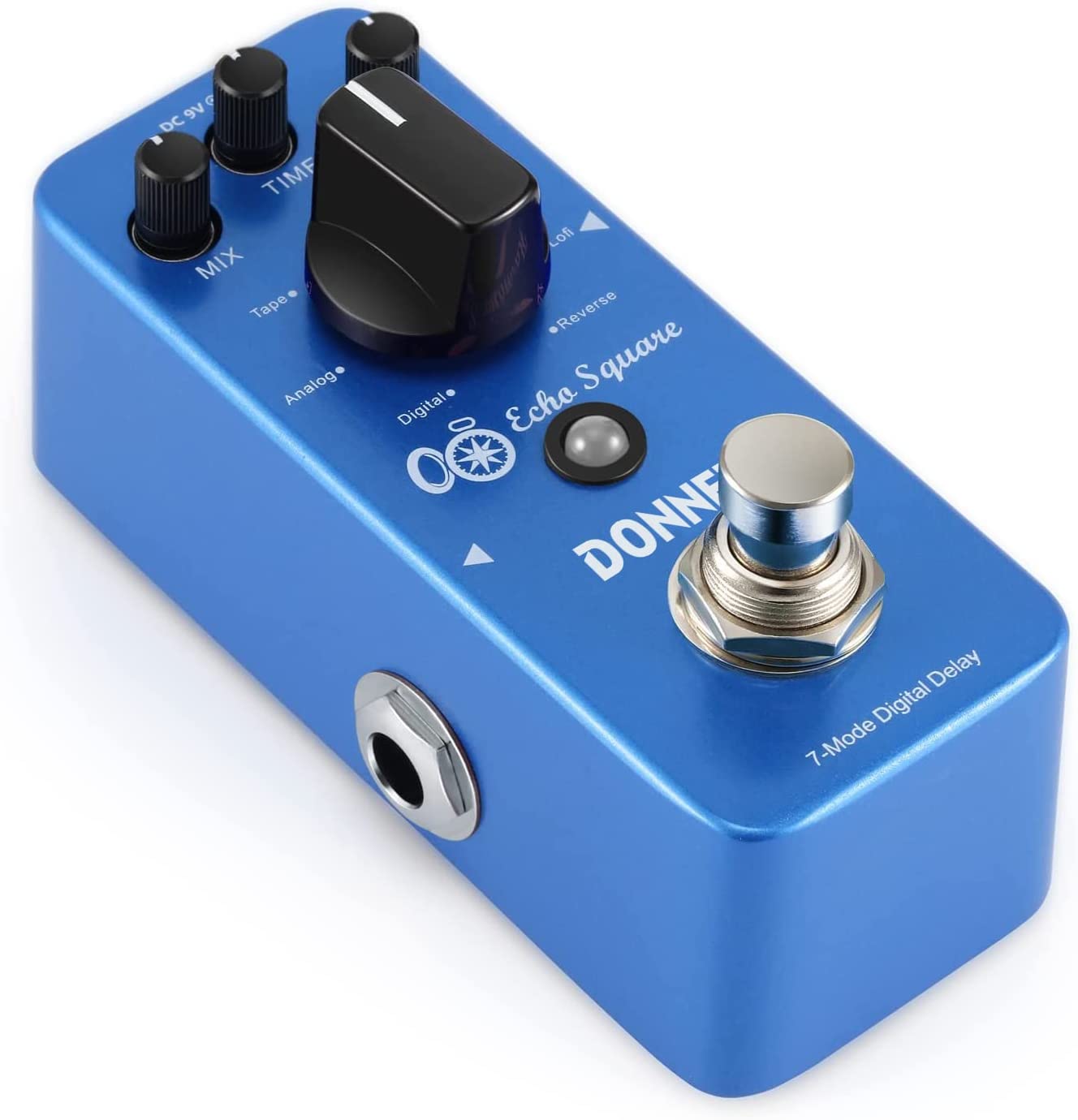
Crafted with care, the Donner Echo Square Delay Pedal is a specialized guitar accessory tailored for musicians seeking variety in their sound.
This device, encased in a robust, blue-toned, aluminum-alloy body, flaunts seven unique delay modes, including digital, analog, tape, mod, sweep, lofi, and reverse.
Equipped with three control knobs, the pedal enables musicians to finetune their output.
The MIX knob adjusts the dry-to-effect signal ratio, while the TIME knob controls the delay period, ranging from 20ms to 838ms.
Meanwhile, the F.BACK knob adjusts the feedback quantity.
Powered by a 9-volt adapter (not included), this digital circuit pedal promises a transparent tone courtesy of its true bypass feature.
Weighing a mere 270 grams, the Donner Delay Pedal combines versatility and compact design at your fingertips, ready to inspire your sound.
Remember, this pedal shines the most when its LED indicator is on, revealing its active status and your passion for music.
- My Review
This Donner Delay Pedal is like a compact music studio, quite a powerful gadget for its size.
Weighing in at just 270 grams, it’s light enough to leave a trace in your gig bag barely, yet it packs quite a punch with its seven delay modes.
From digital to reverse, each mode brings flavor, like the different spices you’d use in a complex recipe.
Adjusting the knobs on this thing felt like steering a space shuttle.
For example, with the MIX knob, I could juggle the dry and effect signal balance, an essential trick for fine-tuning your sound.
On the other hand, the TIME knob allowed me to play with delay times from 20ms up to 838ms, like adjusting the hands on a clock.
And let’s not forget the F.BACK knob, our feedback controller, as crucial as the rudder on a ship.
The true bypass feature stood out to me about this delay pedal.
This design choice was as clear as a glass of pure water, maintaining an authentic, unaffected tone when the pedal wasn’t in use.
In addition, its aluminum-alloy body felt robust and sturdy in my hands, a testament to Donner’s commitment to durability.
I found the power supply setup a bit perplexing, like being handed a book without a bookmark.
Here are the ratings I’ll give to the Donner Echo Square Delay Pedal:
You’re expected to provide your own DC 9V Adapter, a little detail that might leave some fumbling around.
The LED indicator was a beacon, lighting my way whenever the pedal was at work, but I wished it were more intuitive.
- Pros:
- Versatile delay modes
- Durable aluminum-alloy construction
- Transparent tone with true bypass
- Compact size and solid build
- Cons:
- Potential for outside interference
- Switching settings may be indistinguishable
- LED behavior during operation
- Limited subtlety in the mix knob
My final verdict is that the Donner Delay Pedal is a solid choice for guitar and bass players looking for a versatile and compact delay pedal.
Its various delay modes, durable construction, and transparent tone offer great value for the price.
However, it may have minor drawbacks, such as potential interference and limited subtlety in the mix knob.
Considering its features, performance, and brand reputation, the Donner Delay Pedal receives a positive recommendation.
FLAMMA Digital Stereo Delay Pedal
Compact FS03 delay pedal with 6 classic effects, tap tempo, storable presets, looper, and true bypass.
The FS03 Digital Delay with Looper Pedal is a compact and easy to use pedal that features 6 digital delay effects, 80-second looper recording capacity, tap tempo control, preset saving, and trail on function. It offers intuitive knobs and control, adjustable parameters, and a range of effect modes to find your perfect tone quickly and conveniently.
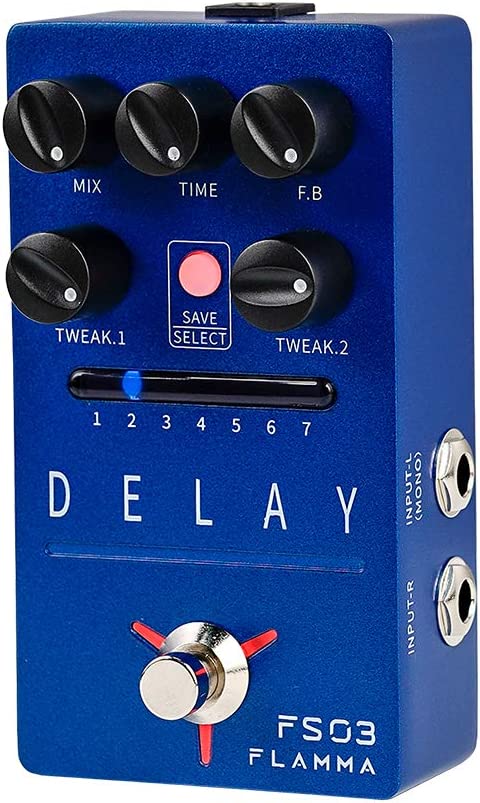
Taking your sonic creativity to the next level is the Flamma Digital Stereo Delay Pedal.
Tailor-made for guitar enthusiasts and musicians, this compact gadget elevates your music experience.
With seven distinctive delay types, it’s not just a one-trick pony; it’s an orchestra of possibilities at your fingertips.
From subtle echoes to boisterous repetitions, you’re in full control.
Moreover, this delay pedal stands out for its tap tempo function.
Perfect for those on-the-fly adjustments while in the middle of a riff.
Pair it with its memory function, which can recall up to five presets, and you have a versatile tool ready for any performance.
As if that wasn’t enough, it packs stereo inputs and outputs for maximum integration with your current setup.
Don’t worry about being digital; Flamma ensures no degradation of your guitar’s tone.
This gadget is a delight for any guitarist, offering the potential for truly immersive musical expressions.
- My Review
The Flamma Digital Stereo Delay Pedal it’s like having a sonic Swiss army knife in your guitar bag, truly a jack of all trades.
Seven delay types with unique characteristics transform your sound into an audible dreamscape.
Echoes weave like silken threads through your melody, while repetitions punch in like a well-timed comic’s punchline.
It’s not just playing music, it’s like painting with sound.
That tap tempo feature? Picture this, you’re mid-jam, and suddenly, the groove switches up.
Then, keep the music flowing into the new tempo without missing a beat.
It’s like having a third hand – simply brilliant.
Five memory slots and five musical landscapes are ready to explore.
Like bookmarks in your favorite book, jump right to your most-loved settings.
The versatility, it’s like having your cake and eating it too.
However, a word of caution here.
While it’s true that the stereo input and output make integrating this pedal into your setup a breeze, it can feel like a double-edged sword if you’re a fan of mono.
It’s like driving a sports car on city streets – yes, it’s fantastic, but it’s not for everyone.
And the digital design?
It’s like a carefully preserved masterpiece in a museum.
Your original guitar tone remains untouched, unblemished by the digital workings inside.
All in all, it’s fair to say that the Flamma Digital Stereo Delay Pedal is like a perfectly mixed cocktail – diverse ingredients blending into one satisfying experience.
Here are the ratings I’ll give to the FLAMMA Digital Stereo Delay Pedal:
Sure, it has a few quirks, but then again, what piece of gear doesn’t?
It’s all part of the charm.
- Pros:
- Compact size and well-built.
- Offers 6 traditional stereo delay effects.
- Includes an 80-second capacity looper.
- Storable presets for personalized sound.
- Tap tempo function for precise control.
- Cons:
- Some users experienced difficulties with the looper.
- Adjusting tone parameters affects the guitar’s clean tone.
- Extra effects on certain delay modes may not be satisfactory.
- Limited preset saving capability (one preset per mode).
- True bypass function causes slight tone degradation.
My final verdict is that the FLAMMA FS03 Guitar Delay Pedal is an excellent choice for guitarists.
Its high versatility, extensive features, rich tone, solid performance, reputable brand, and great value for money offer a compelling package for musicians of all levels.
Whether a beginner or a professional, this pedal delivers the quality and functionality to enhance your guitar-playing experience.
Seymour Duncan Vapor Trail Delay Pedal
Authentic vintage tone with clarity, warmth, and modulation.
Vapor Trail is a true analog delay pedal with Bucket Brigade circuitry to provide vintage tone with clarity, warmth and presence. It has responsive modulation controls, TRS insert and a Delay knob with a blue LED to give visual feedback of delay time. Hand-assembled in Santa Barbara, CA.
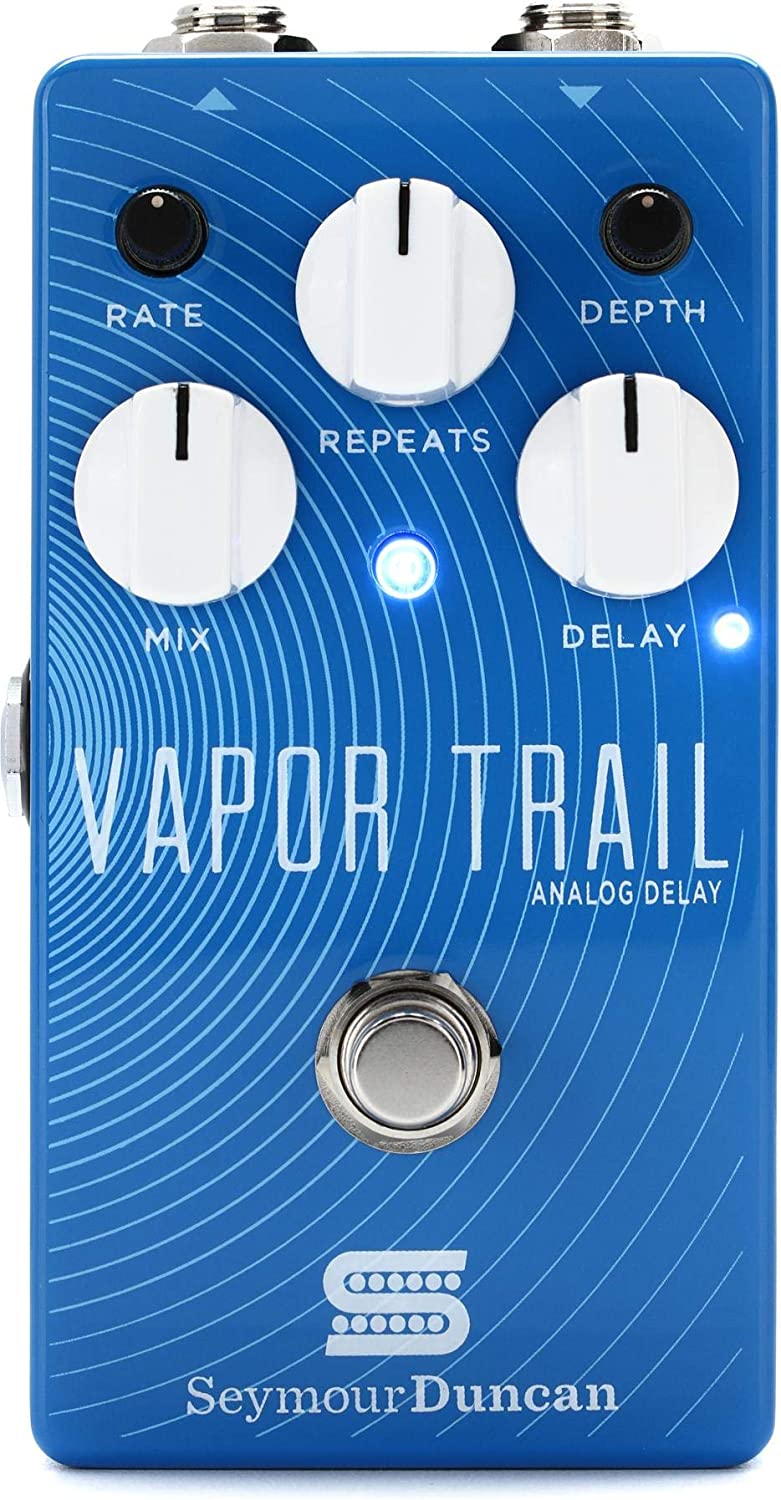
Boasting an elegant silver hue, the Seymour Duncan Vapor Trail is an authentic, analog delay pedal crafted for electric guitars, boasting an elegant silver hue.
In addition, this gadget incorporates the revered Bucket Brigade circuitry, providing clear, warm, and vintage tones that musicians covet.
Designed with a true bypass, it includes a power supply option of either an internal 9V battery or an external regulated power supply ranging from 9V to 18V.
One of its key highlights is the TRS insert jack.
This feature allows you to creatively process the repeats through extra effects, offering a fresh take on what you can do with an analog delay.
Furthermore, the Vapor Trail’s natural compression and treble-smoothing properties tend to bolster, not overwhelm, the dry note.
But, if you wish, you can max out the controls for fun ray gun and spaceship noises.
With its compact dimensions and lightweight design, it’s no wonder that the Vapor Trail is making a splash in the music world.
- My Review
Diving into the sonic world with Seymour Duncan’s Vapor Trail Delay pedal, I’m met with a sonic landscape teeming with analog warmth and textured echoes reminiscent of the vintage Bucket Brigade Device tones.
This thing packs a serious punch in a compact, silver package that’s easy on the eyes.
It’s a nod to the bygone era of authentic guitar sounds, yet it struts into the future with its innovative features.
Powering up, the Vapor Trail goes the extra mile by offering a choice between an internal 9V battery and an external 9V-18V regulated power supply.
That’s a nifty bonus, like the cherry on top of a sundae!
Diving into its functionality, the TRS insert jack is a stroke of genius.
It’s the key to a hidden kingdom of auditory creativity, allowing the processing of delay repeats through additional effects.
In a nutshell, it’s an invitation to redefine analog delay.
A sweet bonus is the pedal’s natural compression and treble-smoothing properties.
They work like a seasoned bartender, knowing how to mix the sounds, favoring the dry note but never letting it drown the party.
Cranking up the controls, the Vapor Trail can moonlight as a sci-fi sound designer, belting out fun spaceship and ray-gun noises.
The Delay knob had me at hello.
With a little trick up its sleeve, it’s not just a functional knob; it’s also a cool blue LED that pulses to the rhythm of your delay time.
Playing on a dimly lit stage, that LED was my beacon, guiding me toward the perfect delay time.
It’s got the old-school charm, the futuristic features, and the small conveniences that make it a delight to use.
Is it perfect? Well, nothing is. But it comes mighty close.
It’s an analog delight, dressed in a sleek silver chassis, that breathes new life into any guitar rig.
Here are the ratings I’ll give to the Seymour Duncan Vapor Trail Delay Pedal:
This is Seymour Duncan’s Vapor Trail Delay pedal through my eyes (and ears).
It’s been a blast!
- Pros:
- Warm, vintage tones
- Lush modulation
- TRS insert jack for additional effects
- Natural compression and treble-smoothing characteristics
- Intuitive and well-balanced controls
- Cons:
- No dedicated on/off switch for modulation
- Some units may have different knob design
- Possible quality issues with battery cover and LED light
My final verdict is that the Seymour Duncan Electric Guitar Multi Effect Vapor Trail Analog Delay Pedal is an excellent choice for guitarists seeking warm, vintage tones and versatile delay effects.
With its intuitive controls, lush modulation, and TRS insert jack for additional effects, this pedal offers a range of creative possibilities.
In addition, the brand’s reputation for quality and attention to detail adds to its appeal.
While minor cons exist, such as the lack of a dedicated on/off switch for modulation and potential variation in knob design, overall, the Vapor Trail delivers performance and value.
It is a worthy addition to any pedalboard and receives a positive recommendation.
Boss DD-500 Digital Delay Pedal
Powerful digital delay with twelve versatile modes and deep editing options.
The BOSS DD-500 is the most powerful and versatile digital delay stompbox ever created, offering 12 distinct delay modes and unprecedented real-time control and sound-sculpting abilities. With 32-bit AD/DA, 32-bit/96 kHz processing, and customizable control settings, this stereo pedal packs a punch of creative power for the stage and studio.
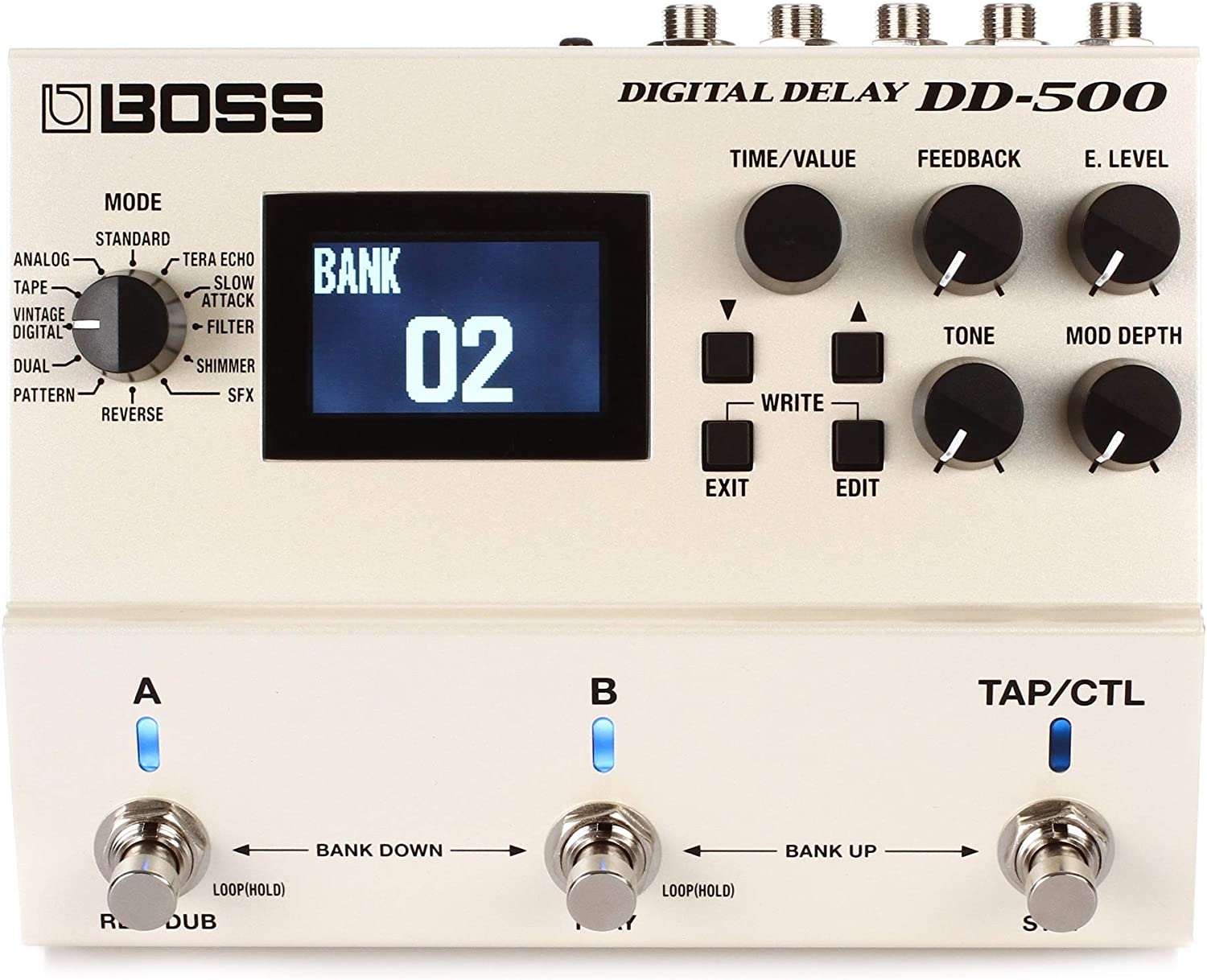
Boss’s DD-500 Digital Delay guitar pedal offers a broad range of customizable settings and delay modes, making it an outstanding tool for musicians seeking to add depth to their sound.
In addition, the device is a blend of advanced technology and user-friendly design, allowing players to create unique sound textures.
This stompbox delay boasts 12 distinct delay modes, from vintage to modern.
So whether you prefer the warm echo of classic devices or modern lines with unique processing, you can fine-tune your sound with the DD-500.
Each delay type offers semi-parametric four-band EQ, modulation, and ducking settings.
Boasting 32-bit/96kHz processing, this delay pedal delivers unrivaled sound quality in every mode.
Notably, the DD-500 lets you choose between buffered and true-bypass operation, letting you fit it into your setup in the way that best suits your style.
For tech-savvy players, the DD-500 connects via USB for remote editing and patch backup.
It also supports MIDI, further expanding your control options.
The pedal’s design includes a sizable, integrated LCD for clear visibility and smooth navigation during a performance or tweaking settings.
- My Review
Sliding my fingers over my trusty guitar, I cued up the Boss DD-500 Digital Delay pedal, a contraption that promises to be more than just your average effects unit.
As soon as the first chord reverberated, it was clear; this is your run-of-the-mill stompbox.
Immediately, I was greeted with a palette of twelve flavors of delay, each more distinctive and rich than the last.
It’s like diving headfirst into a sea of sound, each wave providing a new sonic experience.
Likewise, the pedal delivered echoes with each strum ranging from crystal clear digital repeats to warm, nostalgic analog-like tones.
It’s the audio equivalent of a chameleon, adapting to any sonic environment I throw at it.
Exploring its features further, I found the equalizer akin to a master chef’s toolkit, ready to season my music just how I like it.
The controls are smooth, responsive, and intuitive, allowing quick adjustments on the fly or deep dives into intricate sound sculpting.
Not to mention the DD-500’s superior sound quality.
Its high-resolution 32-bit/96kHz processing provides the clarity you’d expect from studio-grade equipment.
It’s like having some Abbey Road right at my feet.
Even with its complexity, the DD-500 never sacrifices quality.
But where this pedal shines the brightest is in its connectivity.
It has a USB port, a rare gem in stompboxes, making remote editing and patch backups a breeze.
Not to mention, the MIDI capabilities unlock a whole new dimension of creativity and control.
The DD-500 isn’t without its challenges, though.
Here are the ratings I’ll give to the Boss DD-500 Digital Delay Pedal:
Its comprehensive feature set may be overwhelming for beginners, and the number of parameters can be daunting.
However, with patience and experimentation, it becomes an unmatched creative partner, ready to serve whatever your musical taste buds crave.
- Pros:
- 12 versatile delay modes.
- High-quality 32-bit/96kHz processing.
- Customizable control settings.
- Cons:
- Power supply not included.
- Not true stereo.
- Complex interface for some users.
My final verdict is that the Boss DD-500 Digital Delay is a highly versatile and feature-rich pedal with excellent tone and performance capabilities.
The strong reputation of the Boss brand and its value for money make it a worthy addition to any musician’s setup.
Strymon TimeLine Delay Effects Pedal
High-quality Strymon TimeLine Delay Pedal with 12 delay types, 200 built-in presets, and extensive MIDI support.
TimeLine is a complete delay machine with 200 built-in presets, analog sound, stereo looper, and extensive MIDI support. It has a display to show delay time or preset bank, Type to choose from Digital to Tape, Value to control delay parameters, Time to set delay time, Repeats and Mix for echoes, Filter for sound shape, Grit for distortion, Speed for delay modulation LFO, Depth for intensity, and Expression Pedal Jack for control.
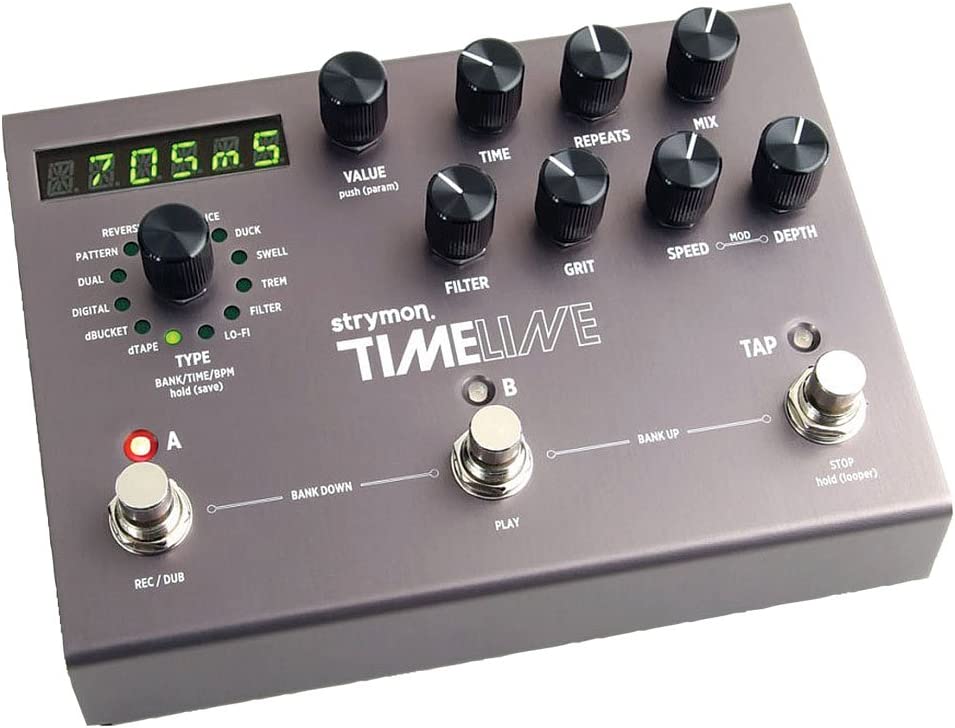
Meet the Strymon TimeLine, an innovative Delay Effects Pedal with a reputation for studio-class performance.
This compact device is a treasure trove of delay options, offering 12 unique delay machines that cater to a wide range of musical tastes.
It’s not just a simple effects pedal – the TimeLine is powered by a high-performance SHARC DSP that squeezes out every bit of processing power for incredible sonic detail.
Despite its intricate design, the Strymon TimeLine is friendly on the user interface.
Its neatly laid-out controls offer extensive control over the pedal’s sonic character, making it a breeze to shape the sound to your liking.
There’s room to store up to 200 of your preferred settings.
At the heart of the pedal, there’s a 30-second stereo looper which you can route pre- or post-delay.
If you love presets, you’ll find the 200 built-in presets handy.
You can even plug in an expression pedal to control any knob, all saveable per preset.
And for those with more complex setups, the pedal’s extensive MIDI support will come in handy.
Its robust construction is matched by its physical dimensions, which measure 9.9 x 3.7 x 5.6 inches and weigh 880 grams.
In addition, the clear color scheme gives the pedal a sleek aesthetic at home on any pedalboard.
In short, the Strymon TimeLine Delay Effects Pedal is a little powerhouse packed with features to inspire your music creation journey.
- My Review
Unleashing the sonic powers of the Strymon TimeLine Delay Effects Pedal felt like diving into an ocean of echoes, with each ripple of sound more intriguing than the last.
It’s like the Pandora’s Box of delay effects, and the possibilities felt endless – twelve unique delay machines, each vying for attention with its distinctive character.
Let’s talk about this silver-toned marvel’s ability to get in sync with your musical instincts.
It’s all thanks to the MIDI implementation, a feature that, in my experience, was as smooth as silk and as sharp as a samurai’s blade.
It opened up a world of synchrony between the pedal and my other gear. Hats off to the creators for the pedal’s hardware design and processor.
The SHARC DSP was like a busy chef, meticulously preparing each delay effect as a feast for the ears.
And the stereo looper, with its thirty seconds of the creative playground, was the cherry on top.
Now, not everything is great.
While the pedal offers a plethora of sounds and tones, the learning curve felt like climbing a mountain with no end in sight.
From echoey tape delay to crystalline ice delays, mastering each sound was a journey that required both time and patience.
The display and control layout also posed a challenge.
Squinting to read parameters in a dimly lit room sometimes felt like a guessing game.
Moreover, sometimes pressing buttons multiple times before engaging was like dancing with a reluctant partner.
Here are the ratings I’ll give to the Strymon TimeLine Delay Effects Pedal:
Conversely, the same complex design is the secret sauce behind the pedal’s versatility.
So all said and done, the Strymon TimeLine Delay Effects Pedal is a musical voyage in a box, and I’m all in for the ride.
- Pros:
- 12 unique delay machines.
- 200 built-in presets.
- MIDI sync and automation.
- Cons:
- May be expensive for some.
- Small learning curve.
- Some report tone drop.
My final verdict is that the Strymon TimeLine Delay Effects Pedal is a highly versatile and feature-rich pedal with great tone and performance.
The brand is well-respected, but the value may be a concern for some due to its price.
It’s an excellent choice for those seeking a reliable and powerful delay pedal.
TC Electronic ECHOBRAIN Vintage-Style Delay Pedal
Authentic vintage delay with all-analog bucket-brigade circuit.
ECHOBRAIN ANALOG DELAY is a classic, all-analog, bucket-brigade delay pedal that provides up to 300 ms of delay time, with warm vintage echoes and beautiful runaway delays. Its easy-to-use control layout includes Time, Mix, and Repeats, and it features a sturdy metal chassis with dedicated Input, Output and True Bypass.
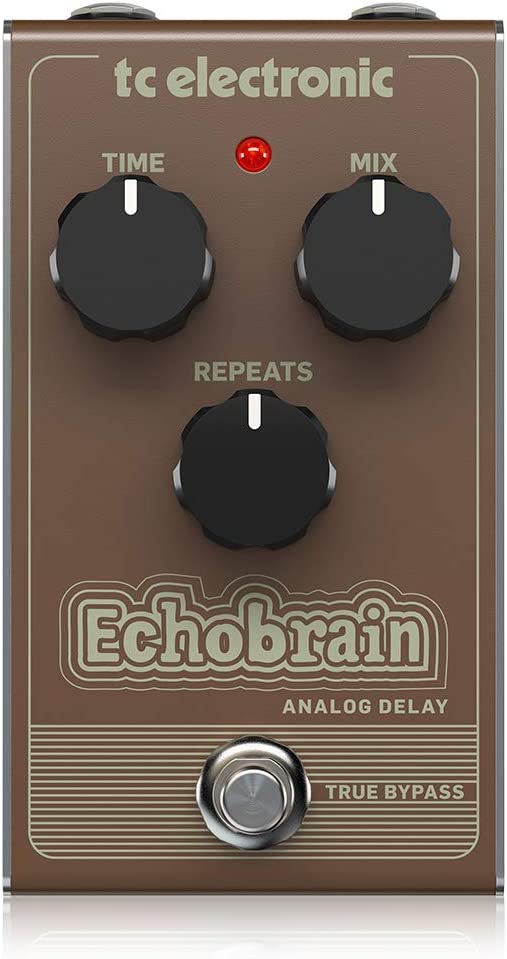
This pedal, the TC Electronic ECHOBRAIN ANALOG DELAY, is a nod to the classic, vintage-style delay effects.
It’s built around an all-analog bucket-brigade circuit, the traditional tech for creating warm, analog delay sounds.
With the ECHOBRAIN, you can dial in anything from tight slap-backs to long, dreamy echoes, perfect for players who value the unique tonal texture of analog delays.
A true bypass is included in the design to maintain the purity of your signal when the pedal is disengaged.
It measures about 5.2 inches in length, 2.28 inches in width, and stands 2.91 inches tall, weighing slightly under half a kilogram.
Powering the ECHOBRAIN requires a nine-volt battery or a TC Electronic Power plug 9, which, unfortunately, aren’t packaged with the pedal.
The pedal’s interface is simple and intuitive, with three control knobs for “Time”, “Mix”, and “Repeats”, letting you customize your sound easily.
It’s a compact, sturdy, and reliable addition to any pedalboard, offering you vintage analog delay tones without breaking the bank.
- My Review
Firing up the TC Electronic ECHOBRAIN ANALOG DELAY, I was immediately drawn to its vintage-inspired aesthetics.
Yet, it’s not all about the looks; the heart of this pedal is an all-analog bucket-brigade circuit, giving it that much-coveted warm, nostalgic delay sound.
Adjusting the simple controls, a world of echo possibilities opens up.
This pedal does everything from short, snappy slap-back echoes to lingering, ambient repeats.
However, there’s a bit of a learning curve.
It’s quite sensitive, and minute changes can lead to significant sound alterations.
So while some might view this as a con, it also provides an opportunity for meticulous sound crafting.
But let’s talk about the ECHOBRAIN’s size.
This pedal isn’t small, and it’s quite hefty.
For a crowded pedalboard, it might be a bit of a squeeze.
Yet, the solid construction more than makes up for it.
This thing could survive a drop from a 10-foot speaker stack.
Regarding the power source, it’s a slight bummer that neither a 9V battery nor a power plug is included.
But let’s face it, most pedal junkies have a spare power supply.
Now, the pedal sports a ‘True Bypass’ feature.
While, in theory, this should maintain signal integrity when the pedal is not engaged, it somewhat affected my tone when switched off.
It wasn’t a deal-break overall, but it’s something worth noting.
Lastly, the delay time is slightly shorter, though decent for most applications.
As a result, it won’t quite get you into the realm of those ethereal, lingering soundscapes.
But for the classic echo effect, it hits the sweet spot.
Here are the ratings I’ll give to the TC Electronic ECHOBRAIN Vintage-Style Delay Pedal:
So, if you’re chasing vintage tones without making a big dent in your wallet, the ECHOBRAIN ANALOG DELAY is a reliable bet.
Just remember, it’s a bit of a space hog, and it might require some extra attention to dial in your perfect echo.
- Pros:
- Vintage style analog delay pedal.
- Affordable and versatile.
- Sturdy metal chassis.
- Cons:
- Limited delay time range.
- Large size and heavy.
- Not true bypass for some users.
My final verdict is that the TC Electronic ECHOBRAIN ANALOG DELAY is a solid choice for musicians seeking a vintage-style analog delay pedal.
It offers decent features, excellent tone, and good performance at an affordable price.
While it has some limitations regarding delay time range and bypass, the overall value and quality from a reputable brand make it a good option for those looking to add this effect to their collection.
Electro-Harmonix Canyon Delay & Looper Pedal
Ten effects plus looper in a compact pedal.
The compact Canyon pedal offers ten awe-inspiring effects, from digital delay to a Deluxe Memory Man emulation, plus a fully featured looper. With internal or external Tap Tempo and tap division, you can easily customize your sound.
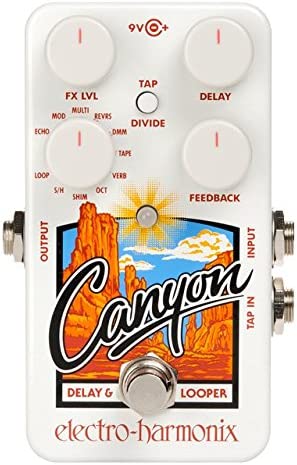
Meet the Electro-Harmonix Canyon, a compact yet powerful Delay and Looper Pedal.
Crafted in a sleek white design, this pedal delivers astonishing effects, from the pristine digital delay to the warm, warbly tape echo.
Its compact design, measuring 4.5×1.25×2.25 inches and weighing just over half a pound, doesn’t compromise its feature-rich capabilities.
You’ll appreciate its wide delay time range, from 5 milliseconds to 3 seconds, adaptable with tap tempo controlled via the built-in or an external footswitch.
Interestingly, this pedal offers easy access to “hidden” parameters via its Secondary Knob Mode.
Plus, the Tails switch lets you decide whether echoes should repeat or stop immediately when bypassing the pedal.
Bonus features include ten different awe-inspiring effects and a fully-featured looper.
Also, it comes with a standard EHX 9.6DC200mA Power Supply Unit.
With this package, you’ll get a pack of Dunlop PVP101 picks as a bonus!
- My Review
Jumping right in, the Electro-Harmonix Canyon Delay and Looper Pedal really feel like a tiny, white box of magic.
Compact as it is, the immense power packed inside this beauty is a force to reckon with.
If delay effects are your jam, this pedal offers a delightful spread—from a clean digital delay to the nostalgic warmth of a tape echo.
As if that isn’t impressive enough, there’s more up its sleeve, with ten stellar effects, including an uncanny emulation of the revered Deluxe Memory Man.
Right off the bat, the design is a nod to durability and functionality.
It’s sturdy enough to stand up to my energetic footwork, yet light as a feather.
It’s easy to fit into any pedalboard setup, and the bonus Dunlop pick-pack is a thoughtful addition.
It might seem a little complex at first, but the learning curve is worth it for the auditory wonders that await.
What caught my attention is the Tap Tempo with tap divide feature—trust me, it’s a game-changer.
It allows precise control over the delay time, whether you’re tapping in sync or setting a delay beat fraction.
Plus, the easy access to “hidden” parameters via the Secondary Knob Mode is like opening a secret door to a treasure trove of tonal adjustments.
Interestingly, the Tails switch adds another dimension to your sound, letting you choose between repeats or an immediate stop when bypassed.
And if looping is your thing, this pedal doesn’t disappoint there either, with a fully featured looper on board.
One hiccup, though: if you’re a simplicity fan, you might be a bit overwhelmed with all these features.
But honestly, that’s the beauty of this pedal.
The potential for sound exploration it offers is as expansive as the Grand Canyon itself.
Here are the ratings I’ll give to the Electro-Harmonix Canyon Delay & Looper Pedal:
All it takes is some quality time to unlock its secrets.
So, yes, the Electro-Harmonix Canyon Delay and Looper Pedal require a bit of dedication—but trust me, it’s a wild ride worth taking!
- Pros:
- Versatile delay and looper pedal.
- Highly adjustable and customizable settings.
- Compact design with powerful effects.
- Cons:
- May have durability issues.
- Learning curve for full understanding.
- Not ideal for looper-only users.
My final verdict is that the Electro-Harmonix Canyon Delay & Looper Pedal is a versatile and feature-rich option for musicians seeking a wide range of customizable delay effects.
Its compact design and powerful performance offer great value for its price.
However, users primarily interested in a looper may want to explore other options.
It’s a solid choice for those looking to expand their sonic capabilities.
Boss DM-2W Waza Craft Delay Pedal
Legendary BOSS quality with all-analog delay and two operation modes.
BOSS provides trusted quality for guitarists of all levels, offering a wide range of amps, effects, multi-effects, loopers, and tuners for optimal sound and performance. With over 40 years of experience, BOSS is a reliable choice for guitarists seeking high-quality gear.
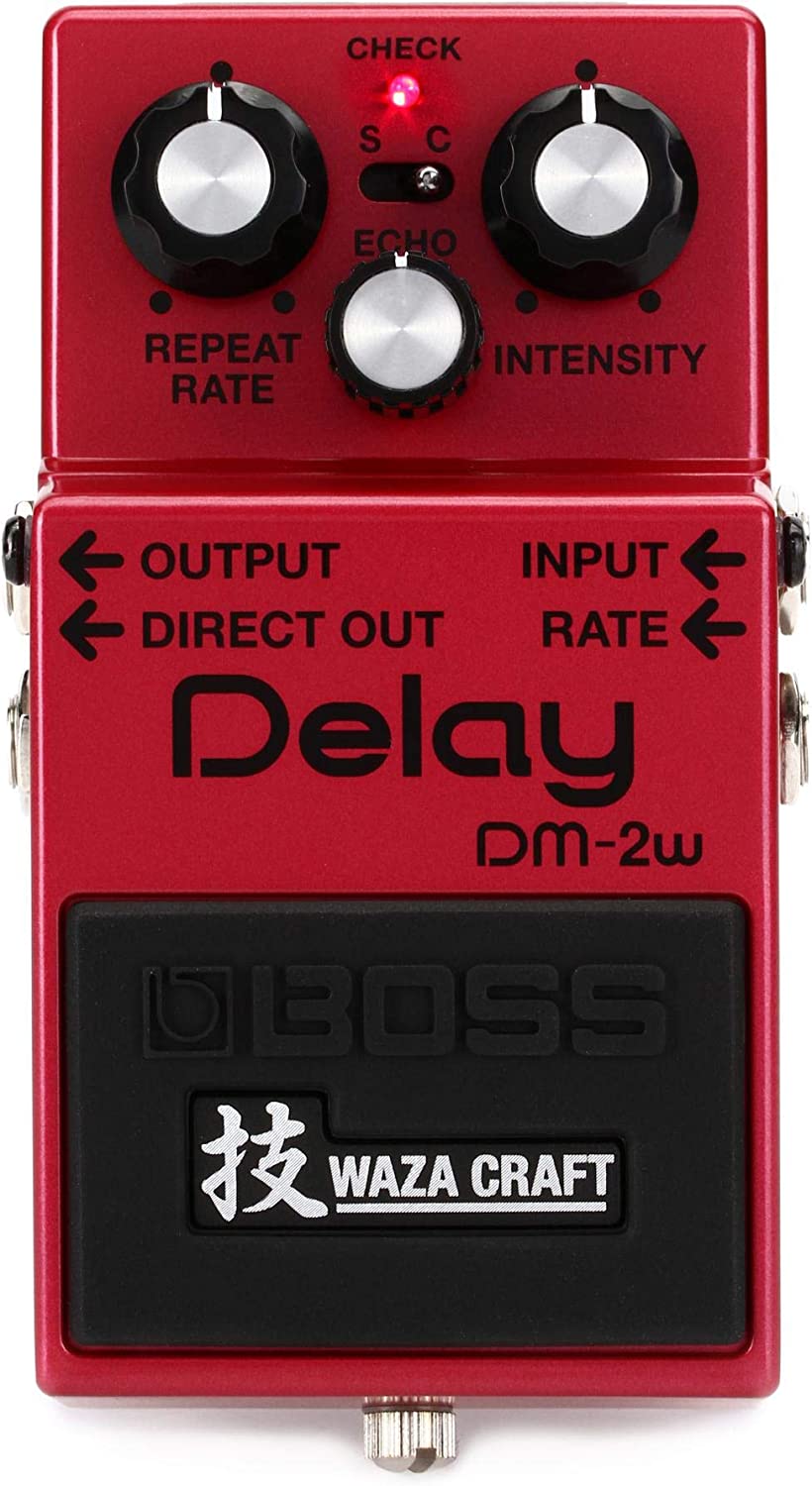
The Boss DM-2W Waza Craft Delay Pedal is a reissue of the highly sought-after DM-2 discontinued in 1984.
This all-analog delay pedal has bucket brigade circuitry, offering warm and lush delay tones.
In addition, it has two operation modes, Standard and Custom, providing versatile sound options for various music styles.
In Standard mode, the pedal reproduces the original DM-2’s 20-300ms delay range, while Custom mode delivers cleaner analog tones with over double the available delay time.
Designed with 100-percent analog circuitry, this red pedal measures 6 x 3.8 x 2.7 inches and weighs 1 pound.
Additional features include expression pedal delay time control and separate wet and dry outputs.
The Boss DM-2W Waza Craft Delay Pedal showcases meticulous attention to detail, refined circuitry, and carefully-selected components, resulting in exceptional tone and touch response.
This pedal is a perfect addition to your gear whether you’re performing on stage, recording in the studio, or simply jamming at home.
- My Review
Having personally experienced the Boss DM-2W Waza Craft Delay Pedal, I can confidently say it’s a fantastic piece of equipment that successfully brings back the warm, lush analog delay sound of the original DM-2.
The pedal’s build quality is solid and reliable, as you’d expect from a brand like Boss.
In addition, it truly excels in delivering that classic “bucket brigade” tone that many musicians, including myself, have longed for since the original DM-2 was discontinued.
One of the best features of the DM-2W is its dual-mode operation.
The Standard mode, reminiscent of the original DM-2, provides a normal delay range of 20-300ms, great for achieving those vintage tones.
On the other hand, the Custom mode offers cleaner, modern analog sounds with a more extended delay time.
This versatility, I found, made it suitable for a wide range of music styles.
Another aspect I particularly appreciate is the pedal’s usability.
The expression pedal delay time control and separate wet and dry outputs are fantastic additions, allowing for greater control over the sound and making it easier to incorporate into any setup.
Moreover, the pedal’s compact size and lightweight design make it convenient to carry around on stage, in the studio, or just practicing at home.
However, the Boss DM-2W has flaws: Some users may find it lacking in versatility compared to more feature-rich delay pedals.
Yet, considering its purpose as a reissue of a classic analog pedal, the focus here is on delivering exceptional warmth and tone above all else.
Here are the ratings I’ll give to the Boss DM-2W Waza Craft Delay Pedal:
The Boss DM-2W Waza Craft Delay Pedal is a remarkable return of the beloved analog delay sound that will undoubtedly please many players searching for that authentic vintage tone.
While it may not be the most feature-heavy pedal on the market, its superb sound quality, reliability, and ease of use compensate for shortcomings.
- Pros:
- Warm, lush analog delay tone.
- Standard and Custom operation modes.
- Sturdy build and compact design.
- Cons:
- Limited features compared to others.
- Pricey for some budget-conscious users.
My final verdict is that the Boss DM-2W Waza Craft Delay Pedal is an outstanding reissue of a classic analog delay pedal, offering excellent tone, versatility, and performance.
It is a worthy investment for musicians and guitarists who appreciate warm bucket brigade-style delay sound and the reliable build quality of a trusted brand like Boss.
Walrus Audio ARP 87 Multi Function Delay Pedal
Walrus Audio ARP 87: feature-rich delay with four algorithms and trails/no trails mode.
The ARP-87 is a feature-rich delay pedal with four main algorithms, smart bypass, and adjustable parameter control. It creates crystal clear repeats, warm analog tones, lo-fi, or classic slap-back echo, and can be run in trails or no trails modes. An isolated power supply is recommended for best performance.
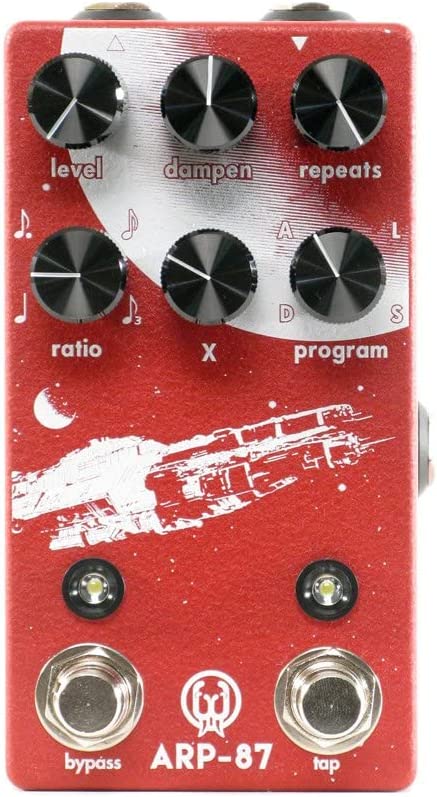
The Walrus Audio ARP 87 Multi-Function Delay pedal, in a striking Limited Edition Red/White color, is a versatile and compact device that offers a wide range of delay tones to enhance your musical performance.
Equipped with four primary algorithms – digital, analog, lo-fi, and slap back – this effect pedal can take your sound to new heights, from crystal clear rhythmic riffs to warm, dimensional chords.
What sets this pedal apart is its ability to adapt to different sound requirements by adjusting specific parameters depending on the selected algorithm.
For example, in the Digital, Analog, and Slap modes, the X knob controls modulation depth, while in the Lo-fi mode, it adjusts the filter width.
The pedal also has an innovative tap tempo feature, allowing you to set the desired tempo without needing a separate “time” knob.
The ARP 87 is designed to offer the choice of using it in trails or no trails mode.
In trails mode, delay trails fade out naturally when the pedal is turned off, while in no trails mode, they are instantly cut.
Hold down the bypass switch for 1 second to switch between modes while powering up the device.
Measuring 5.6 x 3.3 x 2.6 inches and operating at 9 volts, this stylish delay pedal combines practicality with high-quality sound engineering that sets Walrus Audio products apart.
- My Review
Having tried out the Walrus Audio ARP 87 Multi-Function Delay pedal, I can genuinely say that it’s a top-notch device for enhancing my playing experience.
Its versatility in offering four primary algorithms – digital, analog, lo-fi, and slapback – enables me to create diverse sounds and explore new sonic territories easily.
One aspect that stands out to me is the X knob, which adapts to different algorithms smoothly.
It’s like having a secret sidekick, always ready to tweak the modulation depth or filter width to suit my musical needs.
I’m also impressed by the tap tempo feature – no need for a dedicated “time” knob when I can tap my way to the ideal rhythm.
I’ve tried the ARP 87 in trails and no trails modes and appreciated the control it offers.
The trails mode allows delay patterns to fade naturally, adding depth to my sound without overwhelming it, while the no trails mode provides a crisp cut-off for a polished, professional touch.
The dazzling Limited Edition Red/White color caught my eye, but the quality performance and innovative features truly won me over.
My only gripe, if I had to pick one, is the brightness of the light on the pedal.
However, it’s nothing a small sticker can’t fix and certainly doesn’t detract from the pedal’s overall performance.
In a sea of delay pedals, the ARP 87 stands tall, boasting impressive adaptability and intuitive functionality.
Here are the ratings I’ll give to the Walrus Audio ARP 87 Multi Function Delay Pedal:
Whether I’m creating atmospheric ambiances or punchy rhythmic patterns, this pedal never ceases to amaze me with its capacity to elevate my sound.
With Walrus Audio’s commitment to quality shining through, I am confident this pedal will remain a mainstay on my pedalboard.
- Pros:
- Versatile with four primary algorithms.
- Adaptable X knob for different modes.
- User-friendly tap tempo feature.
- Cons:
- Overly bright light on pedal.
- Foot switches may be too close.
My final verdict is that the Walrus Audio ARP 87 Multi-Function Delay Pedal is a top-tier device offering remarkable versatility, innovative features, and exceptional tonal quality.
Its performance consistently impresses me, and the brand’s commitment to excellence is evident.
While it may not be perfect, it holds tremendous value for those seeking a reliable and adaptable delay pedal.
Boss DD-3T Digital Delay Pedal
Classic delay tone with tap tempo and Short Loop function.
The BOSS DD-3T Digital Delay pedal provides a classic delay sound with updated features like tap tempo, direct output jack, and Short Loop function for modern players. It retains the iconic sound and control layout, delivering up to 800ms of delay time with three beat subdivisions.
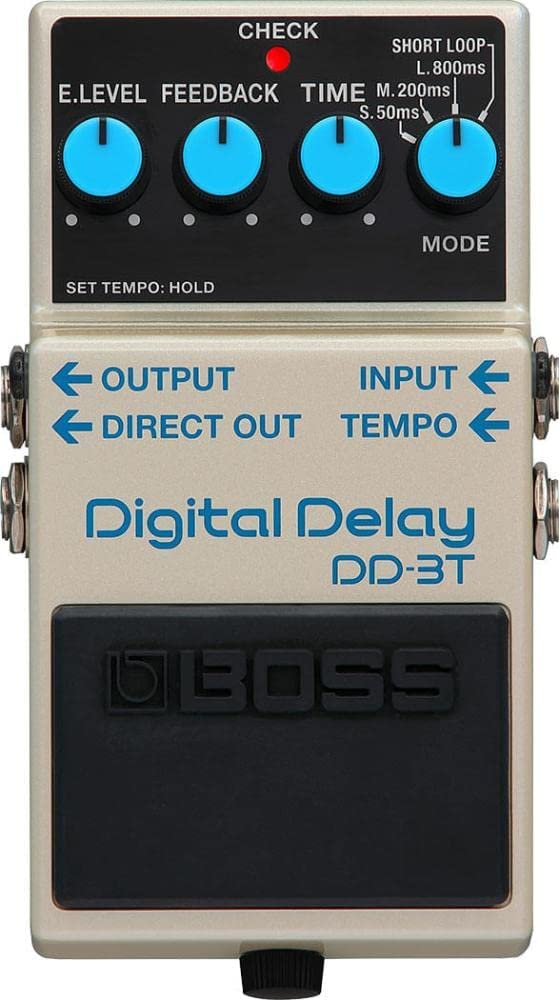
The Boss DD-3T Digital Delay Pedal is a contemporary version of the classic DD-3, designed to cater to the demands of modern guitar players.
Retaining the original’s audio quality and control layout, this enhanced pedal offers extra features such as tap tempo functionality.
You can easily set delay tempos using the onboard switch or an external footswitch, choosing from three-beat subdivisions to suit your playing style.
Simpler connectivity for wet/dry setups has also been enabled, as the direct output jack is now located next to the main output.
One of its highlights includes a “Short Loop” function, originally known as “Hold,” allowing users to play a continuous sound and jam along with a captured loop.
Not limited to delay, this pedal also offers a range of effects like hall reverb when paired with your favorite overdrive or blues pedal.
Crafted for the modern musician, this delay pedal is built to be durable, providing tonal versatility to guitarists of all levels.
- My Review
From my experience with the Boss DD-3T Digital Delay Pedal, I can confidently say it has some profound features that elevate guitar playing to new heights.
Incorporating a fresh tap tempo functionality alongside ease of connectivity, this revamped model has much to offer, while staying true to its classic roots.
Furthermore, the ability to choose from three different beat subdivisions ultimately adds to the versatility of the device – a crucial element for any aspiring musician.
Play-wise, the device caters to guitarists who want to create rhythmic delay effects, sculpting and enhancing the overall sound.
But that’s not where it stops; coupling it with other pedals, even overdrive or blues, enhances an array of rich tones worth exploring.
It’s like producing a symphony using just a single ax!
Psyching up my creativity was where this pedal really excelled; I found the “Short Loop” function ingenious for layering melodies or riffs.
Who wouldn’t love experimenting with different textures to redefine their musical repertoire?
In addition, the pedal has this enigmatic ability to make your guitar sound slightly more transcendent, like a distant, ethereal echo in Da Vinci’s secret music chamber.
However, it’s important to note that I did run into some minor gripes.
First and foremost, I felt the power supply situation was a tad disappointing.
Requiring a specific type of adapter from Boss while guzzling battery life adds an extra purchase I wasn’t expecting.
Beyond that, I did appreciate the pedal’s durability and accessibility to musicians far and wide.
Here are the ratings I’ll give to the Boss DD-3T Digital Delay Pedal:
Ultimately, the Boss DD-3T Digital Delay Pedal ticked most of the boxes for me.
Brimming with exciting features, accessible playability, and morphing adaptability to different pedal setups, this immersive device may be an integral pedalboard constituent for discerning guitarists around the globe.
- Pros:
- Tap tempo functionality added.
- Enhanced connectivity options.
- Combines well with other pedals.
- Cons:
- Specific Boss power supply required.
- High battery consumption.
- Costlier for casual players.
My final verdict is that the Boss DD-3T Digital Delay Pedal is an impressive, flexible addition to any guitarist’s pedalboard.
Despite its pricey nature and specific power supply demands, its performance, remarkable sound quality, and innovative features make it worth considering for both professional and casual players.
What exactly is a delay pedal?
A delay pedal is an essential effects unit that allows guitarists and other musicians to deliberately enhance and alter the sounds they create by digitally generating an echo or repeated signal from the original sound produced by their instruments.
Also known as echo pedals, these iconic sound-processing devices have been a staple in musical landscapes since the advent of integrating technology within music production, with use spanning nearly every genre.

The underlying principle of delay pedals revolves around building sonic layers that can add texture, mood, depth, or spatial dimensions to a piece of music.
Consequently, the pedal caters to various creativity platforms or embellishment applications with borderless universes of mind-bending possibilities.
Delay pedals receive input signals or audio data from instruments through direct input or jack.
They subsequently replicate and manipulate these signals according to parameters and settings previously designated on the unit through frequency processing hardware, analog circuits, or digital software processing systems they exhibit.
Technically, the mechanism responsible for replicating incoming waveforms lies in buffering audio data segments (working as a chunk of data that gets looped) in electric charges or switchable capacitors.
Dissipating the gaps at both onset and offset notes, these audio data alterations can be saved or canceled instantly concerning the guitarist’s whimsical moods.
The audio interactions strive for analog and discrete.
Subsequently, the contrasting spaces of continuity generate an output signal coherently knotted to its former input.
What to consider before buying a guitar delay pedal?
Before you buy a guitar delay pedal, there are some things to consider, for example, some of these things include price, quality, and versatility, among other things.
If you’re a beginner guitar player, you probably don’t need a high-end guitar delay pedal, instead, you can choose a less-expensive model and focus on learning how to produce your own sound that way.
Buying a guitar delay pedal may not be an easy task, here are some tips for choosing the best delay pedal:
– Price
Of course, price is one of the most important factors to consider when purchasing any pedal.
Delay pedals can range in price from around $30 to $300, so it’s important to find one that fits your budget.
If you’re a beginner, you may want to start with a cheaper pedal to see if a delay pedal is something you’re interested in without breaking the bank.
On the other hand, if you’re a more experienced player, you may be willing to spend more on a pedal with more features and sounds better.
No matter your budget, there’s a delay pedal out there that’s perfect for you.
The average price of a guitar delay pedal will typically be around $100!
For most people, this is a relatively low price point since, as we all know, it can be expensive to buy a good quality delay pedal; this number will also vary from brand to brand and model to model.
The most basic models we’ve seen start at around $30-$50, but these are usually quite underwhelming in quality.
More expensive pedals will have more features and better sound quality than cheaper ones. However, this is not always the case, and some very good quality cheaper pedals are available.
Try out a few different pedals before purchasing to find the one that best suits your needs.
– Quality
Another important factor to consider is the quality of the pedal; there are many different delay pedals on the market, and some are better than others.
Do your research to read reviews from other guitarists and find a pedal that is known for being high quality so that you don’t waste your money on a pedal that isn’t going to sound good or last very long.
Make sure that the materials used in the pedal have a good reputation so that they will withstand heavy use.
On the other side, it’s also important to find a pedal with good customer support in case you have any problems with it.
When I talk about quality, I mean to include the general way and structure of the buying process and overall experience, not just the pedal itself.
If a company has great customer service and is easy to work with, that’s a big plus.
For example, let’s take a look at JHS Pedals’ contact page:
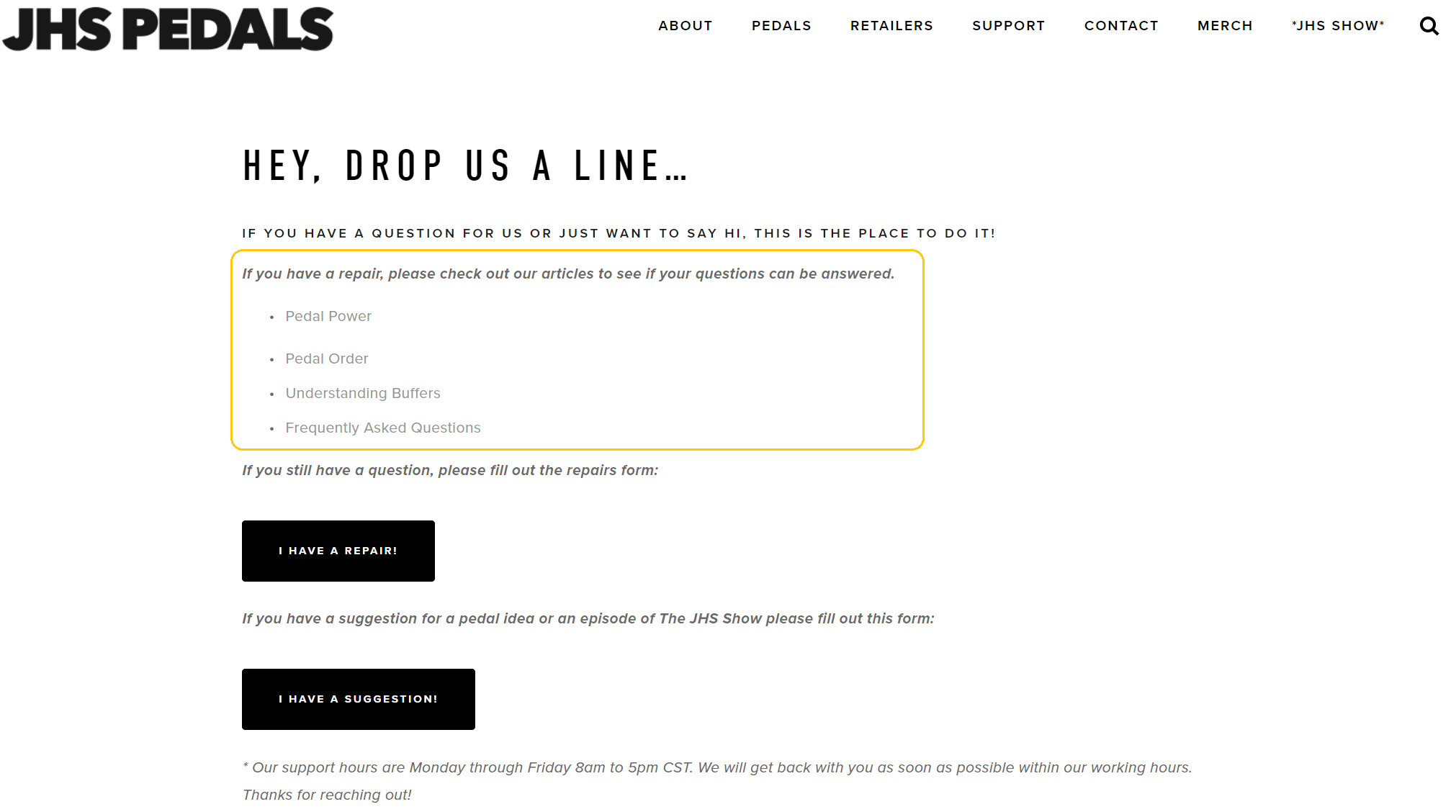
As you can see, they list a few resources so that their users can browse their website before asking any questions, and then on top of that, they give them the option of reaching out.
They encourage others to either ask a question or even suggest a pedal idea or an episode of The JHS Show, which I think is very awesome if they in fact listen to customers like that.
– Versatility
Some guitar delay pedals can be extremely versatile, while others aren’t.
Many models have many settings and are highly customizable, so you can choose from multiple delay times, different pitch variations, and much more.
To go the extra mile, some of them allow you to save these as presets for future use, and even have a phrase looper included!
When buying a delay pedal, you’d want it to be as versatile as possible, meaning it should be able to produce a range of delay sounds.
Ultimately, it all comes down to what YOU want from a delay pedal since different people have different preferences, so make sure you try out a few before settling on one.
– Types of delay
There are many different types of delay pedals on the market today.
Some pedals offer simple repeats, while others can create very intricate and complex sounds, if you’re not sure which pedal is right for you, here is a breakdown of the most popular types of delay pedals available today.
– Digital
A digital delay pedal is a guitar pedal that produces an echo effect by repeating a section of your original signal. The delay effect is created by recording the guitar signal, then playing it back after a set amount of time.
This delay creates a precise, accurate echo effect with minimal noise.

Digital delay pedals often have a longer battery life than other types, making them a good choice for those needing extended performance time.
This type of delay pedal is more complex than analog pedals and offers more options and controls.
They can be set up in a variety of ways and can produce multiple sounds at once, which is useful for creating rich textures in your music.
Some of these pedals also have presets or knobs that allow you to adjust different parameters for additional control over your sound.
We recommend:
– Analog
An analog guitar delay pedal uses a series of analog circuits to achieve its delay effect.
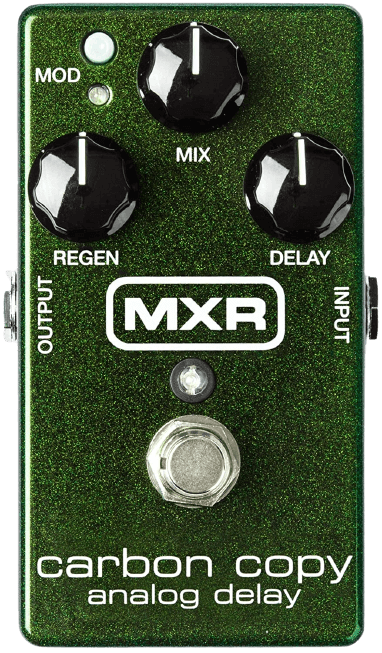
Analog delays are considered “warmer,” or more musical, than digital delays because they produce a sound that is more similar to the original guitar tone.
Many guitar players prefer analog pedals because they don’t add processing to the signal, which can alter your tone and playing style.
This can be especially important when recording live or performing in front of an audience.
Analog pedals also tend to be less expensive than digital pedal options because they use fewer components and less technology in their design.
We recommend:
– Tape
Tape echo is one of the earliest types of delay, and the use of tape delay as an effect is often credited to the legendary guitarist and inventor Les Paul.
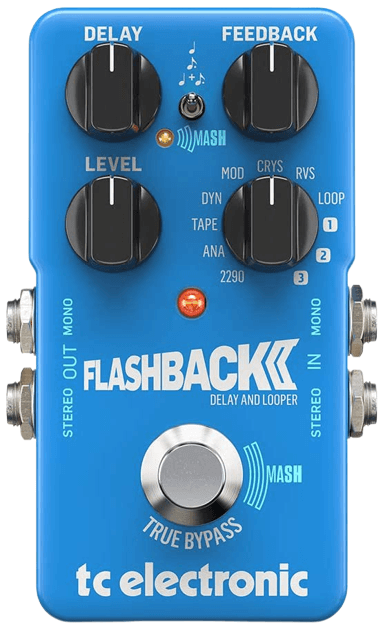
To create it, he used two different machines to record his signal and play it back.
Modern “Tape Echo” delay pedals try to replicate this effect, the tape used in the original versions was inconclusive, although the effect is similar.
Tape delay pedals have a distinctive decayed sound; that being said, not all delay pedals involve tape or would be considered a tape delay.
We recommend:
– Modulated
Modulated delays add modulation to the delayed signal, which can create a wider range of sound, so if you’re looking for a more versatile delay pedal, a modulated delay may be the right choice for you.
Modulated guitar delay pedals can add time or amplitude to an audio performance depending on the model.
The length of the delay controls the amount of time the audio is delayed before it is replayed.
Short delay times are often used in old-school country and surf rock genres, while long delay times can create a canon effect.
Each of these options has its advantages and disadvantages. but in addition, they can be expensive sometimes.
Modulation tends to be more controlled and regular compared to random LFOs (Low-frequency oscillation).
Some delay pedals can even oscillate, which can be particularly useful for achieving specific sound effects or experimenting with various tones.
We recommend:
– Reverse
The reverse guitar delay pedal effect is credited by many to being invented by Danelectro in 1999.
Reverse guitar delay pedals allow you to tweak the wet and dry signal balance, mix, and repeat to create a variety of effects.
This is particularly useful for creating atmospheric layers and dreamy textures in your music.
A good tip to avoid messing with the reverse guitar delay pedal is to mix the signal at a low volume and lock it to the tempo.
We recommend:
– Extra features
If you’re looking to buy a new delay pedal, you’d want to ensure there’s more to it than just being a simple delay pedal.
Many guitar delay pedals come with various features that can be useful for your playing.
For example, some pedals have a tap tempo feature, which is great if you want to keep time with another musician or create a delay effect that’s in time with the music.
Other pedals may have an analog or digital input/output, which can be useful for using the pedal with other devices.
Some guitar delay pedals also come with other built-in effects, such as reverb or chorus; while these aren’t essential, they can be helpful if you want to create a more textured sound.
On the other hand, some pedals can also come with a USB port, which can be handy for using the pedal with a computer or other digital device.
Analog vs Digital delays: Which one should you use?
Analog delay pedals are effects pedals that create a delay effect using an analog circuit.
This type of pedal is often considered more natural sounding than digital delay pedals and can be used to create various delay effects.
In a nutshell, analog guitar delays use Bucket Brigade Device (BBD) chips, which send signals to a series of capacitors; they add a dark character to your music.
Digital delays, on the other hand, use digital signal processors and analog-to-digital conversions.
The latter process records the signal into a buffer and plays it back depending on the parameters you set;. At the same time, both delay types are useful for guitar players, each with advantages and disadvantages.
Analog delays have lower latency, which means the delay time is shorter, on the other hand, digital delays are generally more precise, have better sound quality, and are more flexible.
Digital guitar delays include analog emulations, precise delay time control, and preset memory.
Many guitarists keep both analog and digital delays on their pedalboards!
The difference between digital and analog guitar delays is that the former affects the signal differently, while analog guitar delays, on the other hand, have no digital converters.
They function on an all-analog pathway; in a typical analog delay, the input signal is split into two parts: a dry original signal and a wet delayed signal.
The dry signal goes straight through, while the wet signal is held in capacitors.
Which one should you use?
Analog delays have a warmer, more natural sound than digital delays.
They also tend to be more expensive, so an analog delay is a way to go if you’re looking for a classic delay sound.
If you need lots of extra features and are willing to give up a little warmth, go with a digital delay, you’ll get more bang for your buck, and you can always add an analog delay later if you need it.
No matter which type of delay you choose, try it out in the store before you buy it, listen to how it sounds with your guitar and amp, and see how easy it is to use.
Which is better: Reverb or Delay?
Both reverb and delay are similar and play with the differences between depth and space.
They are excellent ways of adding a larger-than-life feel to an instrument, however, they differ in some major ways.
The difference between the two lies in how they are applied and how they affect the mix of instruments.
Here’s a YouTube video by Mykola MrHardGuitar in which he demonstrates the differences in sound between these two effects:
Reverb gives a mix of more depth, space, and a more natural sound, while delay enables you to amplify the sounds in your track.
Delay is a time-based sound effect that bounces back sound with a specific time interval between instances.
Both reverb and delay are important for guitarists but serve different purposes.
Should you use reverb and delay together?
Yes, you can use reverb and delay together, in fact, many guitarists use both effects to create a more spacious sound.
The thing that makes reverb and delays special is that they are both capable of making something sound bigger than it is.
In some ways, they are similar in their function, but in other ways, they can be used to enhance each other.
One way to think about it is that reverb is more like a “room” or “hallway,” whereas delay is more like a “hallway with mirrors on the walls.”
With this in mind, you can see why they could complement each other very well, even if they’re not always used together.
Reverb can make a sound appear larger by adding depth, dimension, and space to the source material.
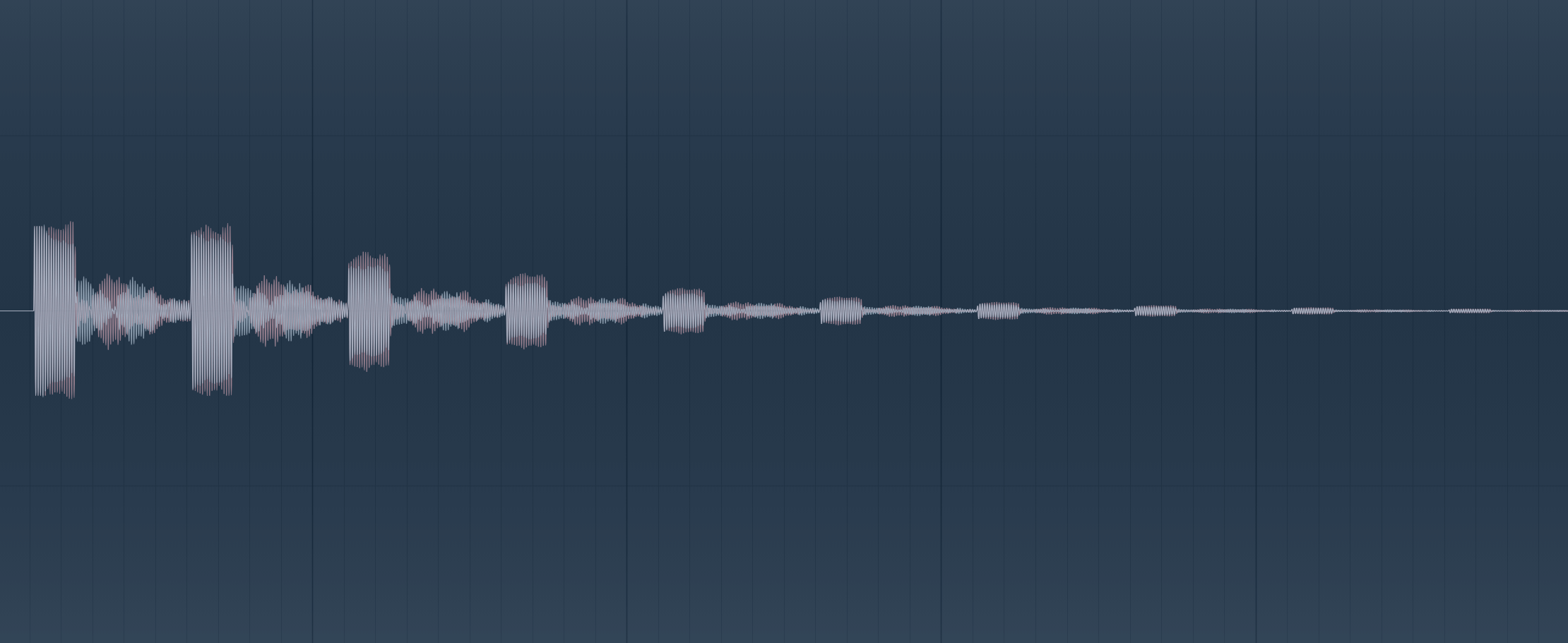
Delay can also add depth and dimension to a sound by making it appear bigger and wider than it was when it was recorded.
Both effects will make your music seem recorded in a large room or hall with lots of space between instruments and vocalists.
Delay can also create interesting rhythmic effects by repeating sounds at different rates (think about how an echo repeats every time you clap your hands).
This has been used extensively throughout popular music since the early days of recording technology because this effect is often very pleasing to listen to.
Here are some tips for using reverb and delay together:
- Start with a short delay time and a long reverb time, this will give your sound a sense of space without sounding too muddy.
- Experiment with different combinations of delay times and reverb times to find the perfect sound for your song.
- Use a high-pass filter on your reverb to keep it from getting too muddy.
- Add a little bit of modulation to your reverb for extra depth and texture, and then control the delay as well.
With a little experimentation, you can create some truly unique sounds by combining reverb and delay. So don’t be afraid to experiment and see what you can come up with!
Are delay pedals necessary to have on a pedalboard?
No, delay pedals are not necessary to have on a pedalboard, however, they can be a useful addition to your rig and I do recommend having some sort of delay available.
Such effect provides great flexibility in creating unique sounds and as we mentioned before, it adds a lot of fullness and depth to your tone.
Delay pedals can be used for a variety of purposes, including:
- Adding depth and space to your sound
- Creating special effects
- Enhancing your live performance
- Making your recordings sound more polished
- And last but not least, delay pedals are simply fun to use!
Here is a video featuring a top 10 list of some of the best delay guitar riffs:
One is “Welcome To The Jungle” by Guns N’ Roses, which uses a delay to create a sense of unease and foreboding in the song’s intro.
How to order pedals on a pedalboard?
There is no one-size-fits-all approach to ordering pedals on a pedalboard, as the optimal arrangement largely depends on the specific sound you’re aiming for.
Usually, though, you will see guitar players mostly agreeing with this order:
Tuner > Filters/Dynamics > Pitch-based Effects > Overdrive/Distortion > Modulation > Time-based Effects > Looper
Aside from that, some general guidelines can help you achieve a balanced and versatile setup.
Let’s talk in detail about the order we just mentioned, but feel free to experiment and adjust to your own preferences:
- Tuner: Place your tuner pedal first to ensure your signal is in tune before passing through the other pedals.
- Filters and dynamics: Wah-wah, envelope filters, compressors, EQs, and noise gates should come next. These pedals affect your sound’s dynamic and tonal aspects, so it’s best to place them early in the chain.
- Pitch-based effects: Octavers, harmonizers, and pitch shifters should come after filters and dynamics since these pedals alter the pitch of your signal and work best with a clean, unprocessed sound.
- Overdrive and distortion: Overdrive, distortion, and fuzz pedals typically come next. They shape your guitar’s core sound, and placing them before most other effects ensures that those effects receive a strong, consistent signal.
- Modulation effects: Chorus, flanger, phaser, and tremolo pedals should be placed after overdrive and distortion effects. We do this to allow these pedals to add depth and movement to your sound without becoming overly distorted or overbearing.
- Time-based effects: Delay and reverb pedals should be placed towards the end of your signal chain. This allows them to create a sense of space and depth around the other effects, simulating the sound of a room or hall.
- Looper: If you use a looper pedal, it should be placed last in the chain. This ensures that you’re looping the entire signal, including all the effects you’ve applied.
Remember, these are just general guidelines and what generally works and sounds good.
The most important thing is to experiment and find the arrangement that best suits your personal sound and style.
For example, here’s one pedalboard signal chain that I always use:
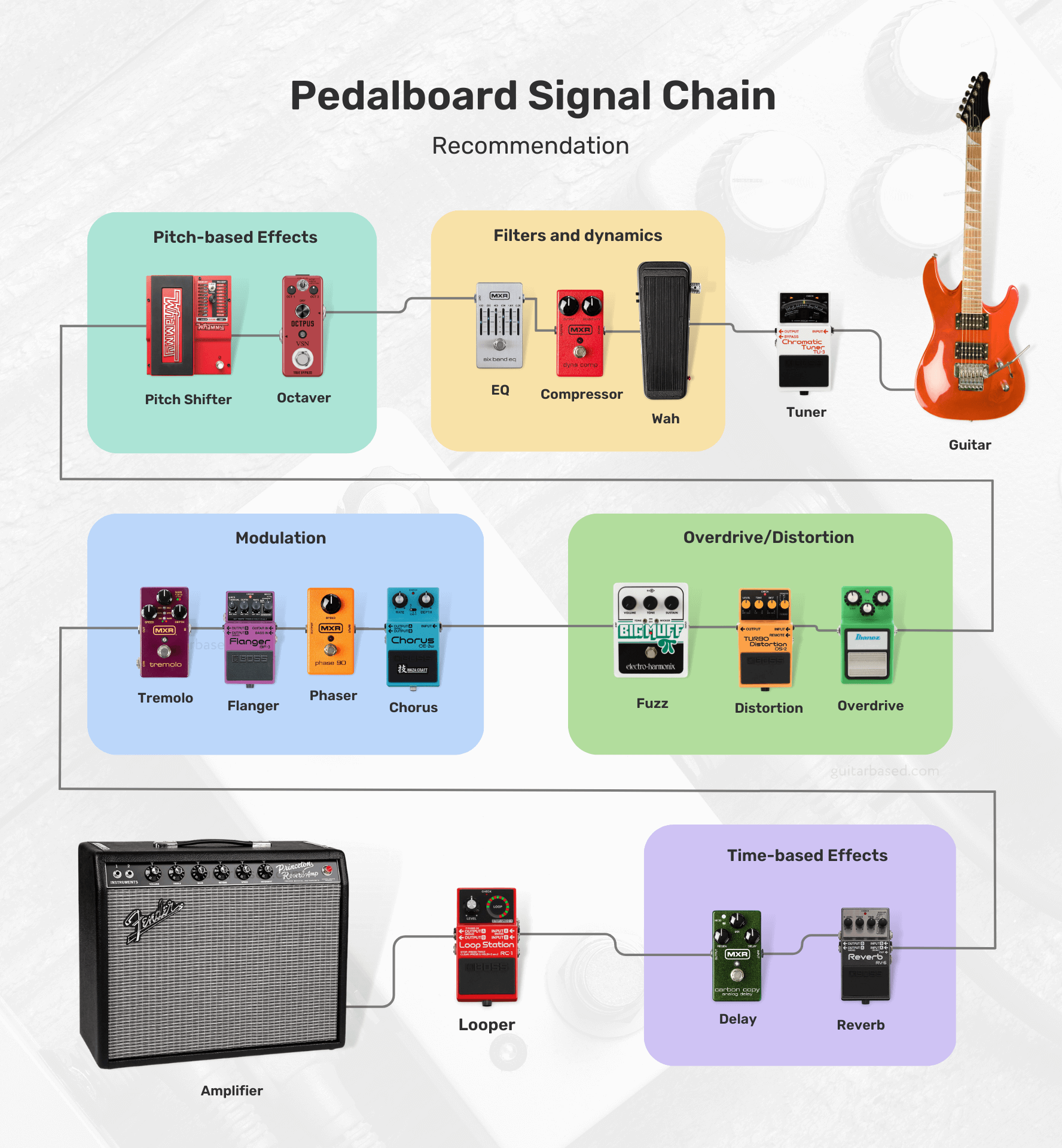
Feel free to swap the order of pedals, try different combinations, and test out unconventional setups until you find the one that works best for you.
For those interested, I’ll leave you with most of the possibilities that you’ll encounter and how to order them.
- Tuner
- Filters/Dynamics:
- Volume
- Wah
- Auto-Wah
- Compressor
- Noise Gate
- EQ (Equalizer)
- Pitch-based Effects:
- Octaver
- Harmonizer
- Pitch Shifter
- Overdrive/Distortion/Fuzz:
- Boost
- Overdrive
- Distortion
- Fuzz
- Modulation:
- Chorus
- Phaser
- Flanger
- Univibe
- Vibrato
- Tremolo
- Time-based Effects:
- Delay
- Echo
- Reverb
- Synth/Bitcrusher:
- Synth
- Bitcrusher
- Acoustic Simulator
- Multi-Effects
- Utility:
- Buffer
- A/B/Y Switcher
- MIDI Controllers
- Looper
Boutique vs. Mass-Produced pedals
Boutique pedals are generally built with higher-quality components and craftsmanship, resulting in better durability and longevity.
These pedals often feature unique and innovative designs, providing a wider range of tones and effects that may not be available in mass-produced options.
Here are a few examples of boutique pedals:

All the manufacturers also tend to have a more personal approach, with better customer service and the ability to customize pedals according to the user’s preferences.
However, boutique pedals are usually more expensive due to the smaller scale of production and the use of premium components.
Mass-produced pedals, on the other hand, are more affordable due to their larger scale of production and the use of cost-effective components.
These pedals are widely available and offer a range of popular effects, making them accessible to a larger audience.
Here are a few examples of mass-produced pedals:

The quality control for mass-produced pedals can vary depending on the brand and model, but many are reliable and offer good value for the money.
As for one of the downsides, you’ll find that mass-produced pedals may not have the same level of uniqueness or innovation as boutique options.
On the other hand, they may not provide the same level of customer service or customization options.
The choice between boutique and mass-produced pedals depends on your personal preferences, budget, and desired sound.
If you’re looking for unique tones, higher-quality components, and a more personal experience, boutique pedals may be the way to go.
But I would say, for those who are on a budget and need access to popular effects, mass-produced pedals might be a better fit.
It’s worth trying out both types to see which best suits your needs and playing style.
How much should you spend on a guitar pedal?
If I were in your position, I would first determine my budget and specific needs before deciding how much to spend on a guitar pedal.
For beginners, it might be more reasonable to start with affordable, mass-produced pedals to explore different effects without spending too much.
Guitar pedals can range in price from around $30 to over $400, depending on the brand, quality, and complexity of the effect.
As your skills and understanding of your preferred tone develop, you can gradually upgrade to higher-quality or boutique pedals.
One thing I would do is consider which effects are essential to your playing style and prioritize purchasing those first.
Allocating a larger portion of your budget to the most important pedals might be a wise choice, especially if you only need a few basic effects.
However, if you require a wide array of effects, you may want to consider more budget-friendly options or multi-effects units.
Keep in mind that higher-priced pedals often come with better build quality, unique features, and improved sound quality.
But I would also say that price is not always directly correlated with quality or suitability for your needs.
Sometimes, a more affordable pedal can deliver the exact sound you’re looking for, while a higher-priced option might not meet your expectations and are only expensive because of the brand reputation.
Can you use a guitar pedal with a bass guitar?
You can certainly use a guitar pedal with a bass guitar.
But it’s crucial to be aware that some guitar pedals may not be specifically designed to accommodate the frequency range of a bass guitar.
This could result in a less-than-ideal performance or an altered tone that might not be what you were expecting.
If you’re feeling adventurous and eager to experiment with your sound, don’t hesitate to connect your guitar pedals to your bass guitar.
This can be a fun way to explore different sonic possibilities, and you might even stumble upon some unique tones that complement your playing style perfectly.
Using a guitar pedal with a bass guitar may not always produce the desired results.
In some cases, the low-end frequencies might be lost, or the effect could sound too harsh or muddy.
To avoid these issues, you could consider looking into pedals that are specifically designed for bass guitars.
These pedals are engineered with the bass frequency range in mind, ensuring that your low-end remains intact and the effect sounds as intended.
In addition to bass-specific pedals, there are also multi-effects processors and pedals that cater to both guitar and bass players, offering a wide range of effects and tonal options.
These versatile units can be a great solution if you play both instruments and want a single device to cover your needs.
How to properly power your pedals?
When it comes to powering your pedals, you want to make sure you’re doing it right to avoid any noise issues or potential damage.
First, check each pedal’s power requirements, which you can usually find in the manual or on the pedal itself.
You’ll want to pay attention to the voltage (usually 9V, 12V, or 18V) and current (measured in milliamps or mA).
Now, you’ve got a few options for powering your pedals.
You can use individual power supplies or batteries for each pedal, but that can get messy and inconvenient.
I’d recommend going for a pedal power supply or an isolated power brick.

For example here are a few ones I recommend:
- Voodoo Lab Pedal Power 2 Plus Isolated Power Supply (My favorite)
- Rowin PW-1 Guitar Pedal Power Supply (Cheapest)
These babies can power multiple pedals at once, and the isolated outputs help prevent noise and ground loop issues.
Just make sure the power supply you choose can handle the voltage and current requirements of all your pedals.
When you’re connecting everything, use good quality power cables and keep them neat and tidy to avoid a tangled mess.
You might even want to use cable ties or cable organizers to keep everything in order.
In love with guitars, and gear; expert in all things music! Been writing about guitars for about 5 years and counting. Born in the ’90s. Alma Mater: University of Havana. Always curious, trying to understand the world. #TeamFender

